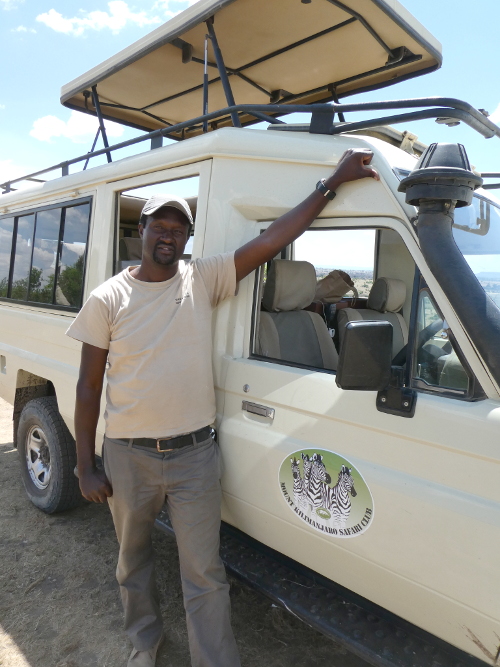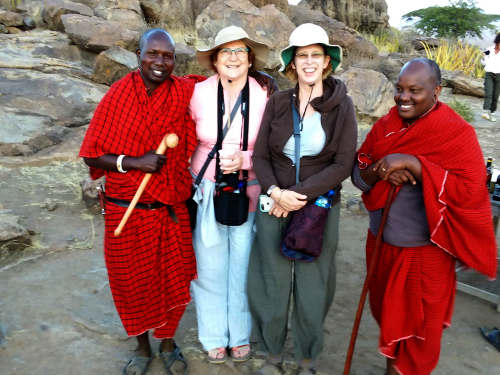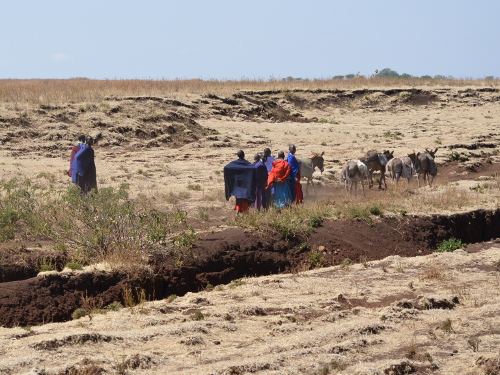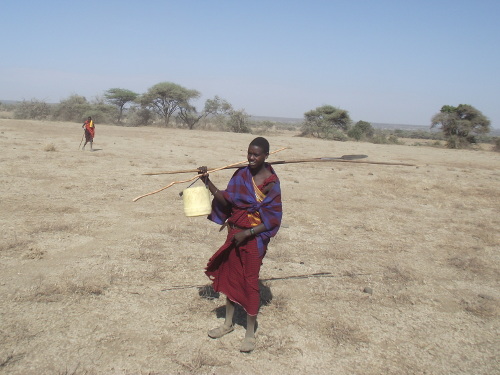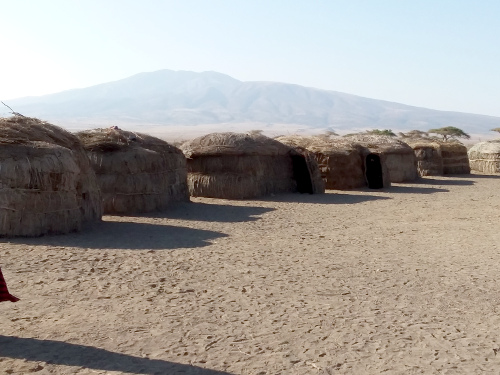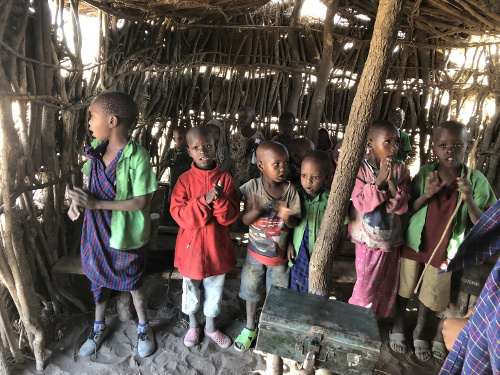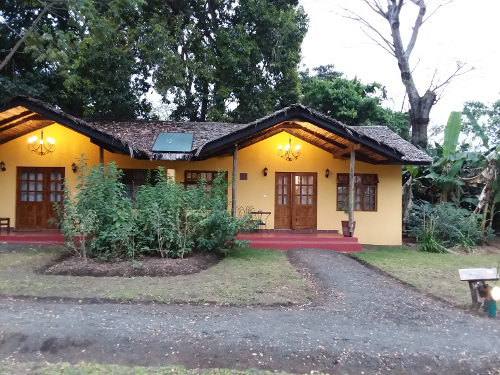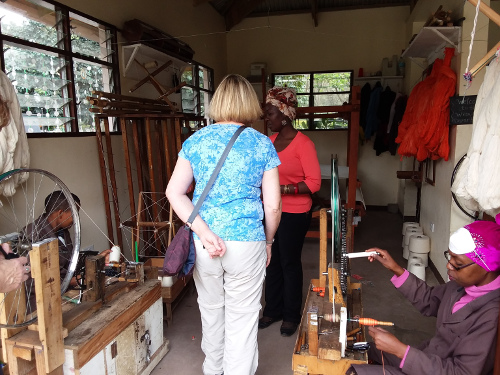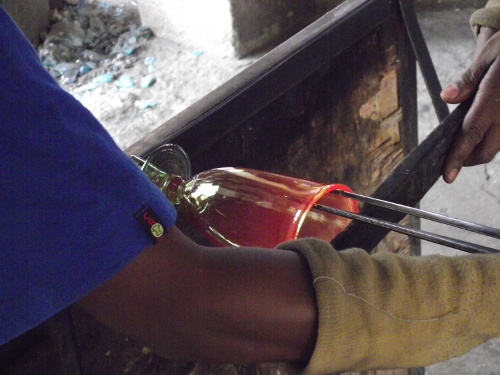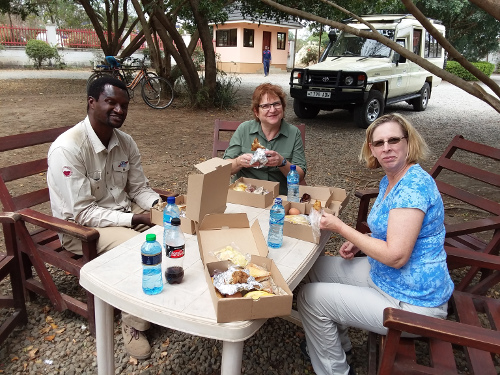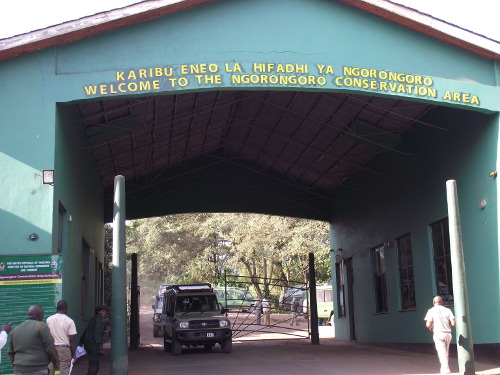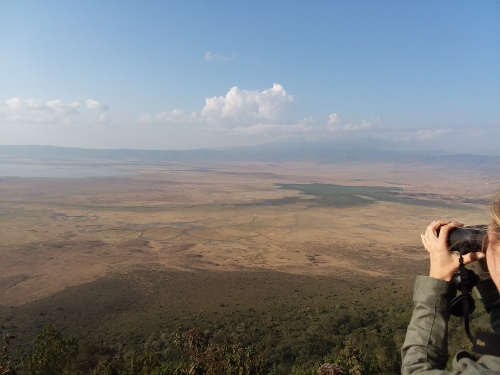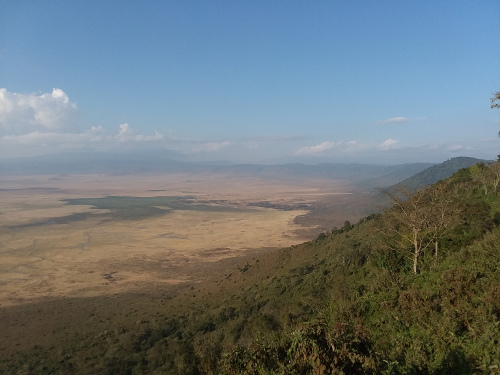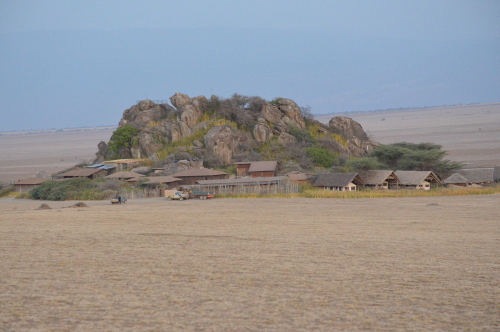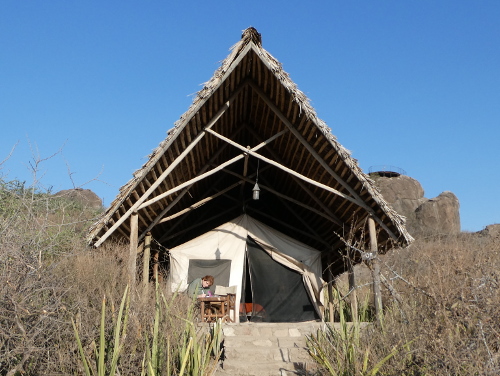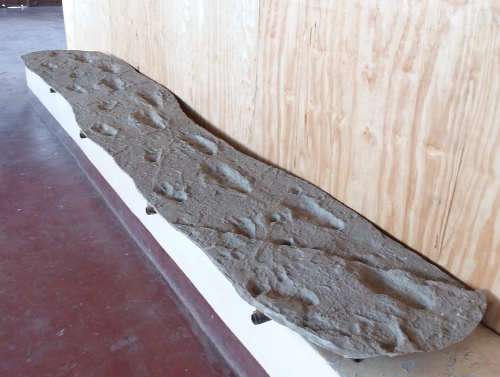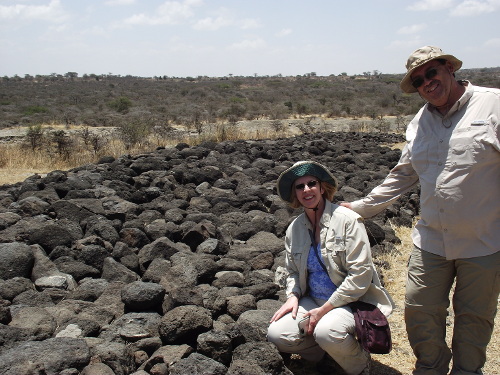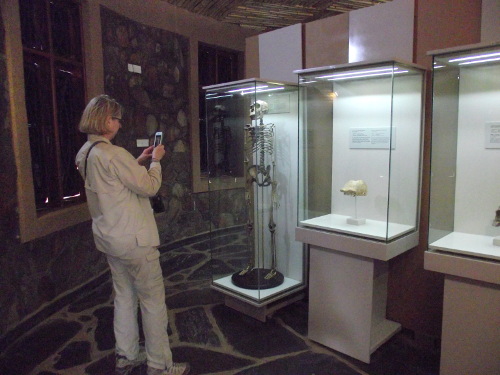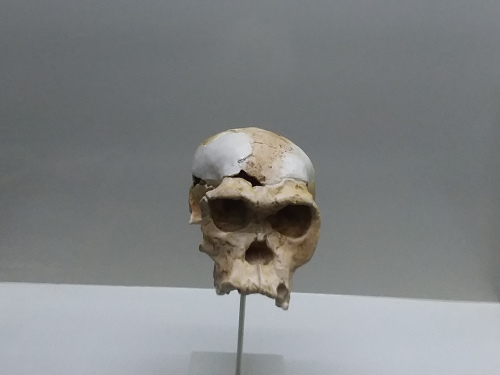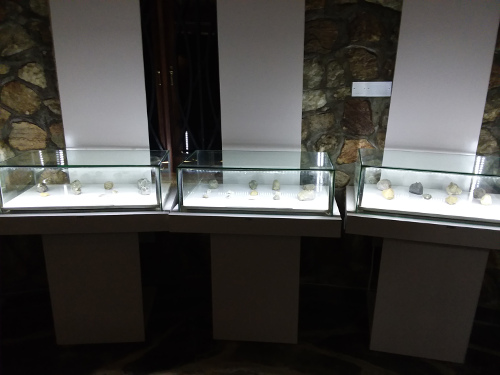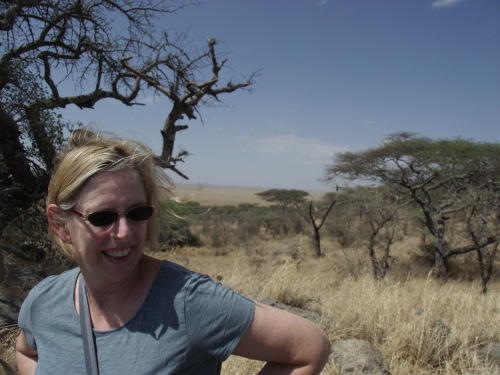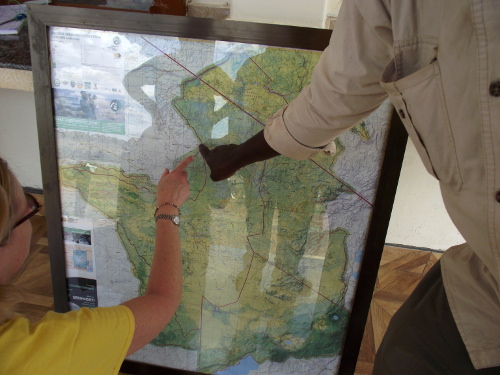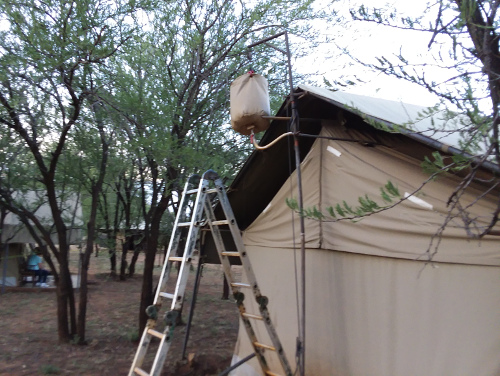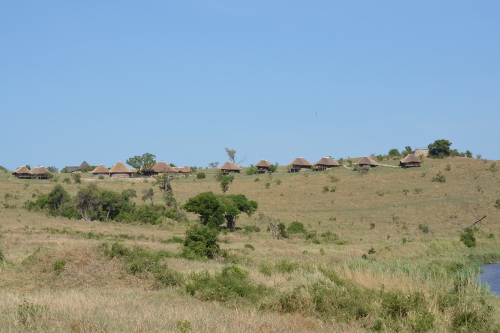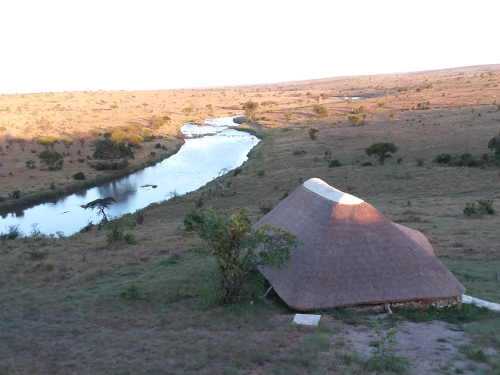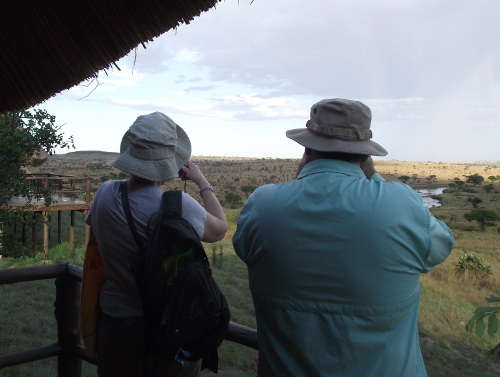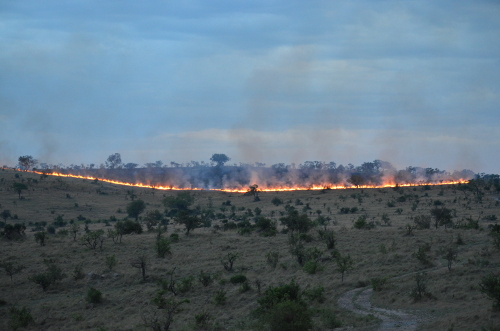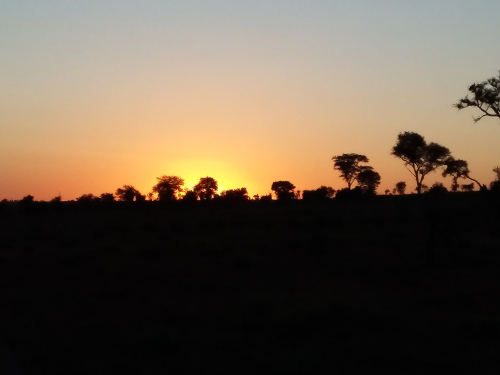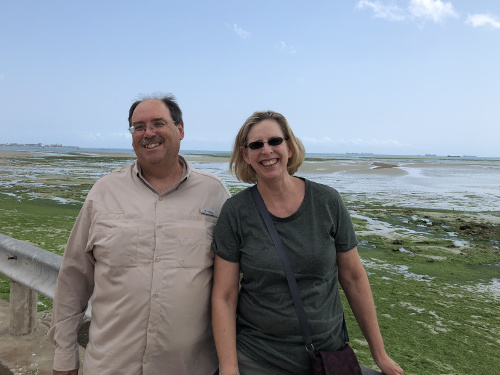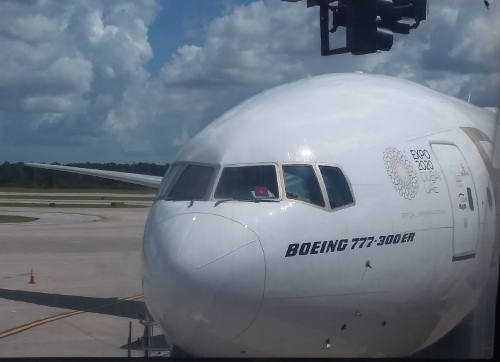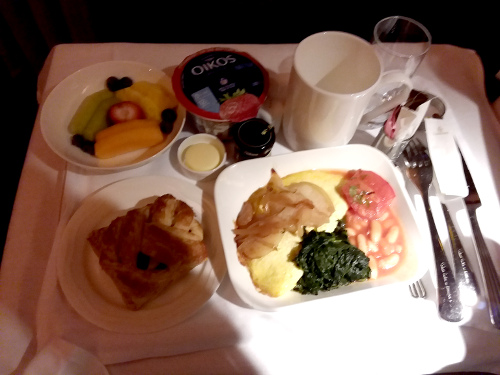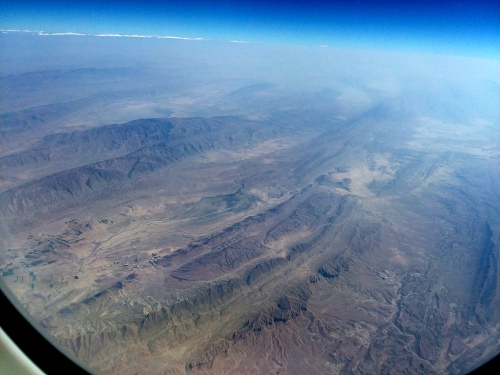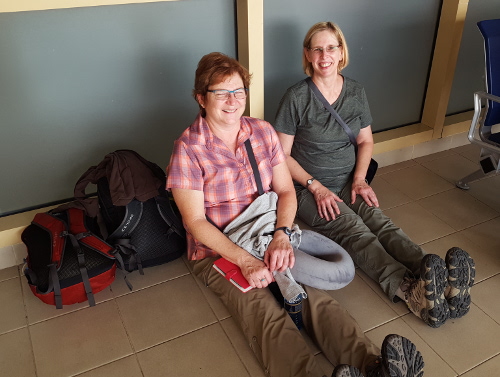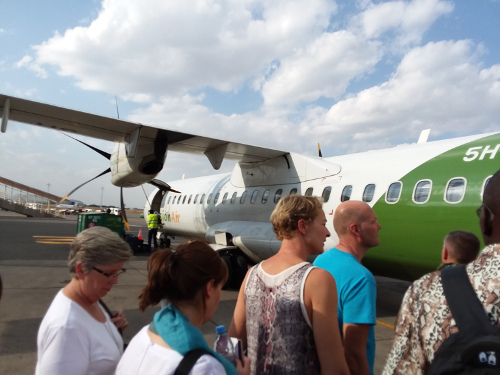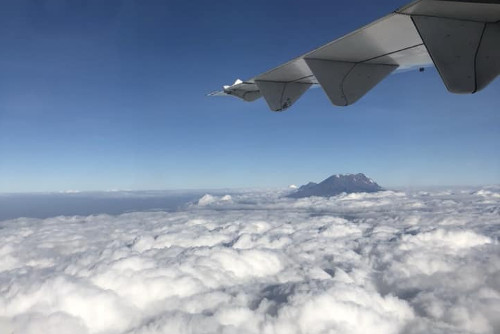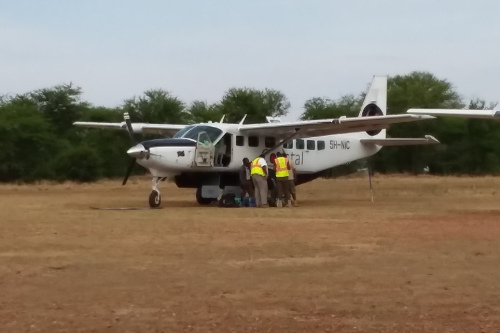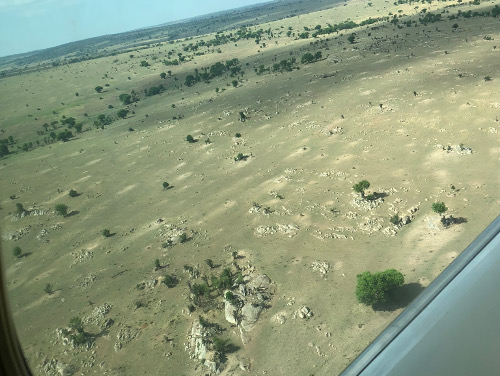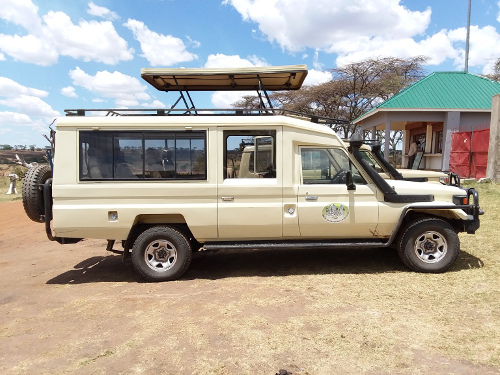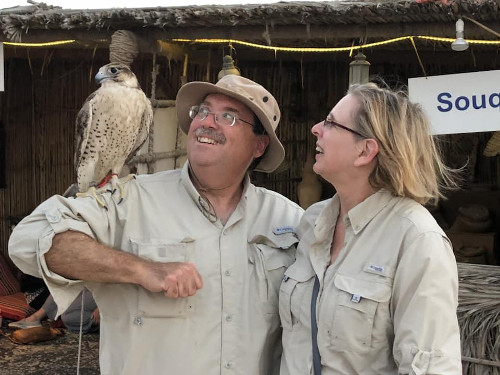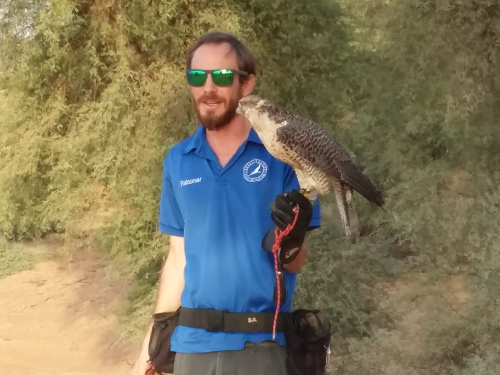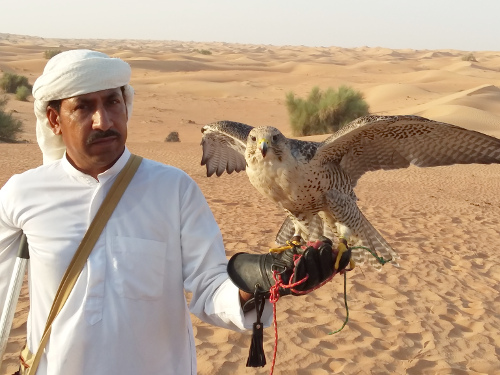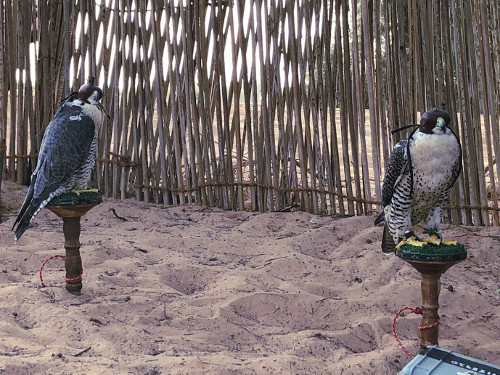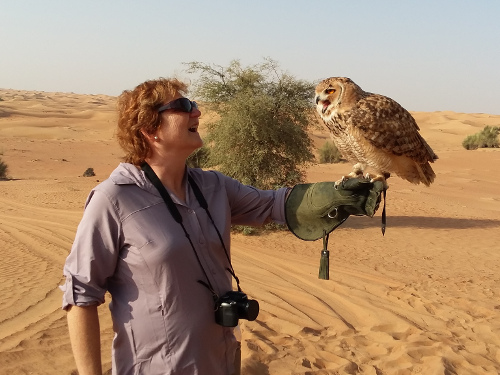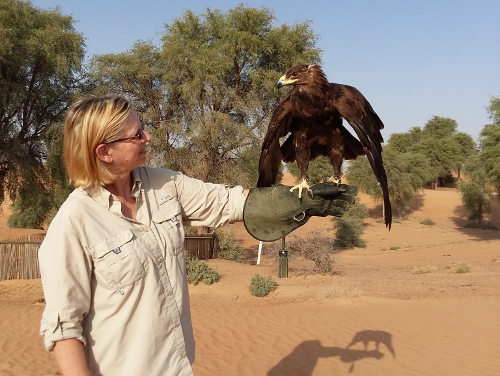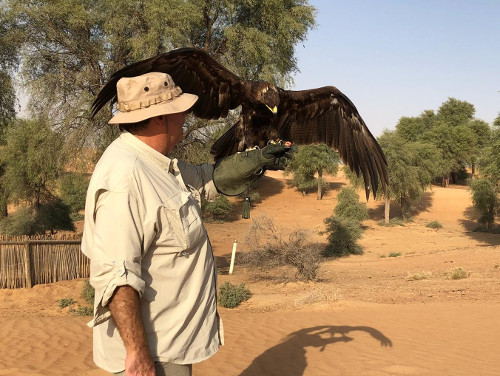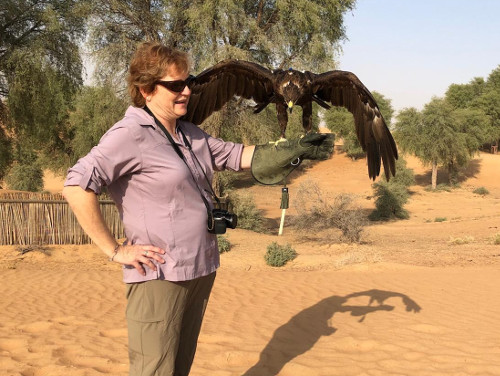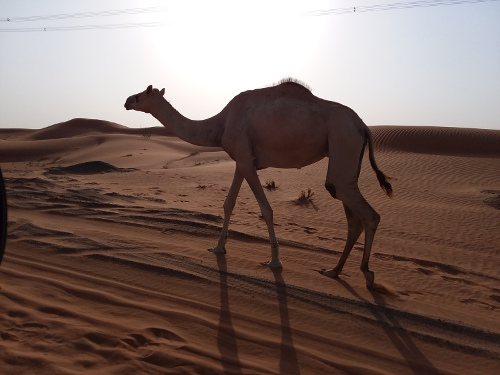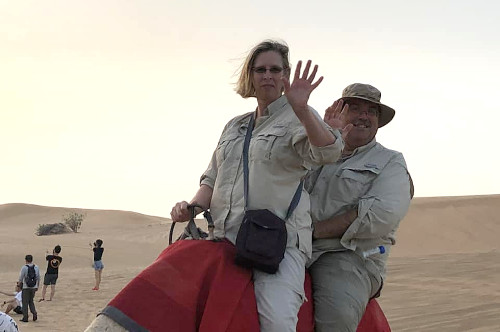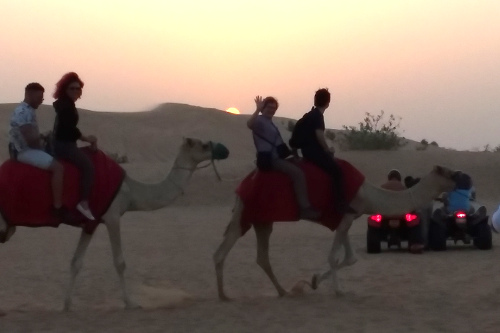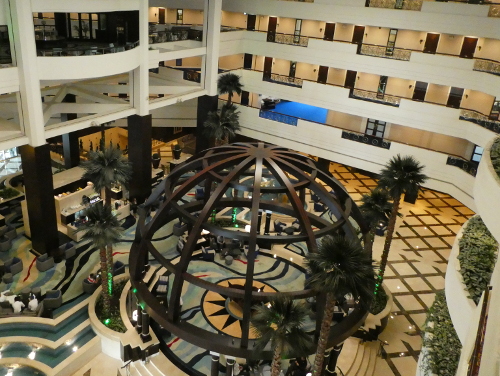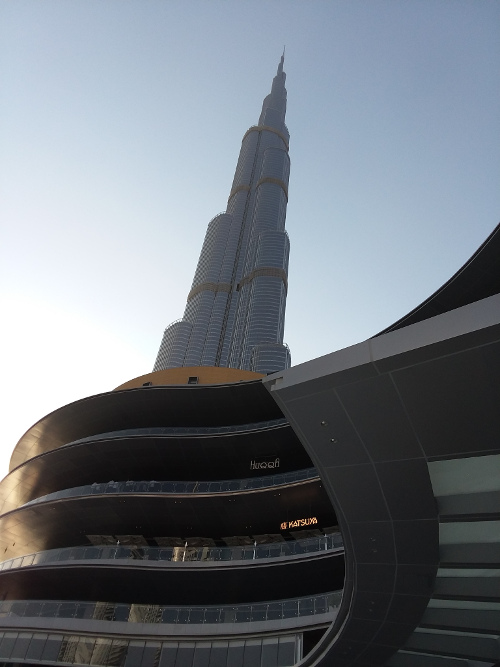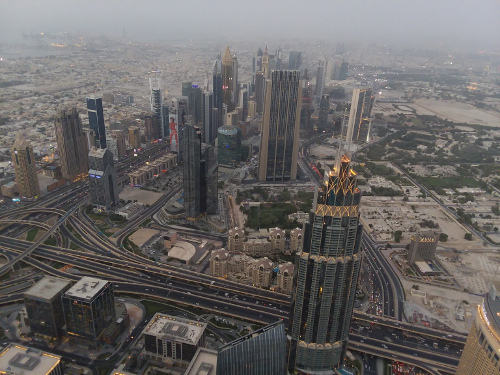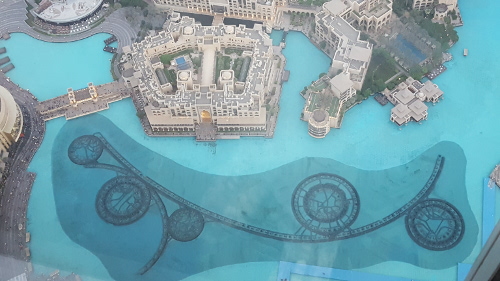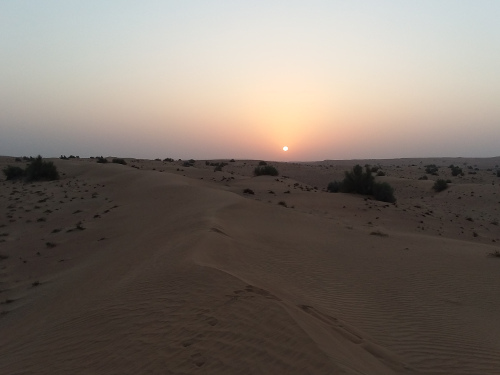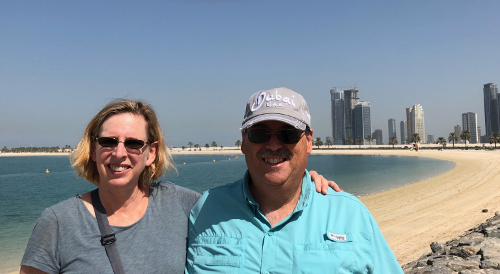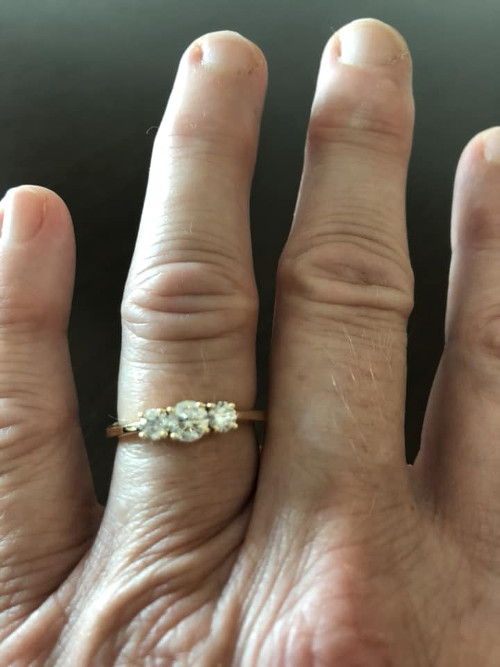Photos and video from our 2018
African Safari in Tanzania and visit to Dubai

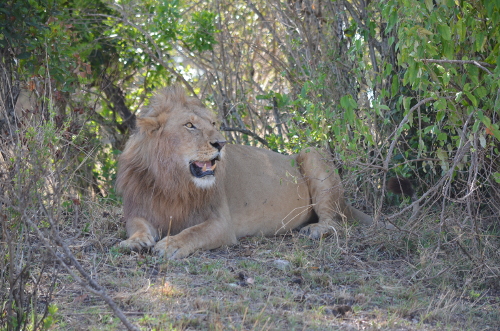 We went on a wonderful eight-day long safari in Serengeti National Park in Tanzania. Plus we stopped over in Dubai for a few days and visited some other places. All together we were
traveling for 15 days and went halfway around the world. It was the trip of a lifetime. We took thousands of photos
and hours of video during the trip. On this page I am going to try to present some of the highlights culled from that massive amount of media. This page will be a work in progress for a while.
I'll continue adding more material as time permits. Check back in the future to see what's been added lately.
We went on a wonderful eight-day long safari in Serengeti National Park in Tanzania. Plus we stopped over in Dubai for a few days and visited some other places. All together we were
traveling for 15 days and went halfway around the world. It was the trip of a lifetime. We took thousands of photos
and hours of video during the trip. On this page I am going to try to present some of the highlights culled from that massive amount of media. This page will be a work in progress for a while.
I'll continue adding more material as time permits. Check back in the future to see what's been added lately.
This page will start with the animals, people and places we saw in Africa. Click here to skip to the section on Dubai.
Here is a photo of a male lion resting in the shade. He's all tired out. He just stampeded away a heard of several thousand wildebeest just by walking out into the open. After they all vanished
over the horizon there was nothing left for him to do but go back to resting and waiting. We got within about 20 feet of him and he paid us no notice at all. The lions totally ignored us for
the most part. They knew we were no threat to them, and they couldn't get at us in the safari truck. So we were essentially beneath their notice. It's good to be the king.
Africa
Animals
Big Animals
Cape Buffalo
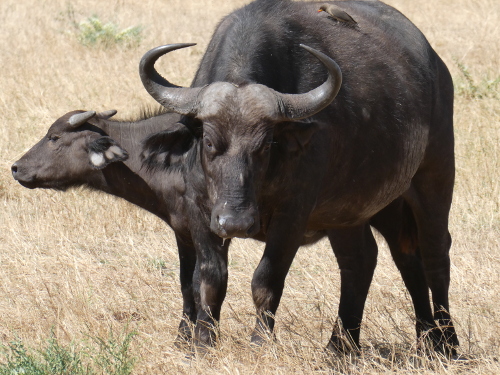 Cape buffalo are one of the so-called big five iconic African animals. They are huge animals, easily weighing more than a ton with huge horns. They are also among the most dangerous
animals in Africa. They may look kind of like cows, but there is nothing domestic about them. Here a mother cape buffalo is standing between us and her calf and eyeing us suspiciously.
Cape buffalo are one of the so-called big five iconic African animals. They are huge animals, easily weighing more than a ton with huge horns. They are also among the most dangerous
animals in Africa. They may look kind of like cows, but there is nothing domestic about them. Here a mother cape buffalo is standing between us and her calf and eyeing us suspiciously.
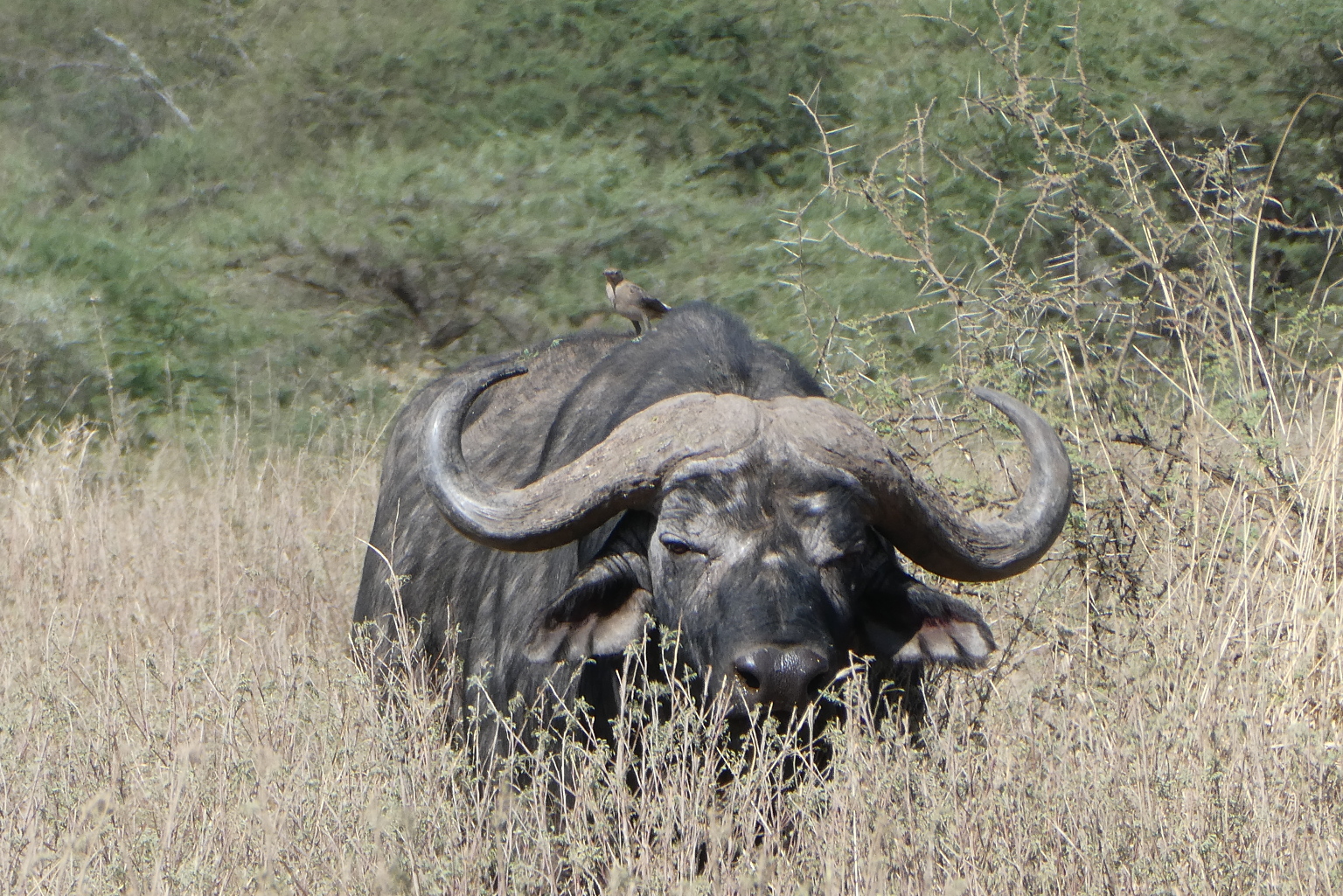 A magnificent old bull cape buffalo in the tall grass, with an ox pecker bird on its back. It's just a huge animal, and those horns are immense.
A magnificent old bull cape buffalo in the tall grass, with an ox pecker bird on its back. It's just a huge animal, and those horns are immense.
Here is a video of a large herd of cape buffalo slowly wondering by us. There are some nursing babies in the group. The video also shows off long views of this very lovely area of the Serengeti.
Elephant
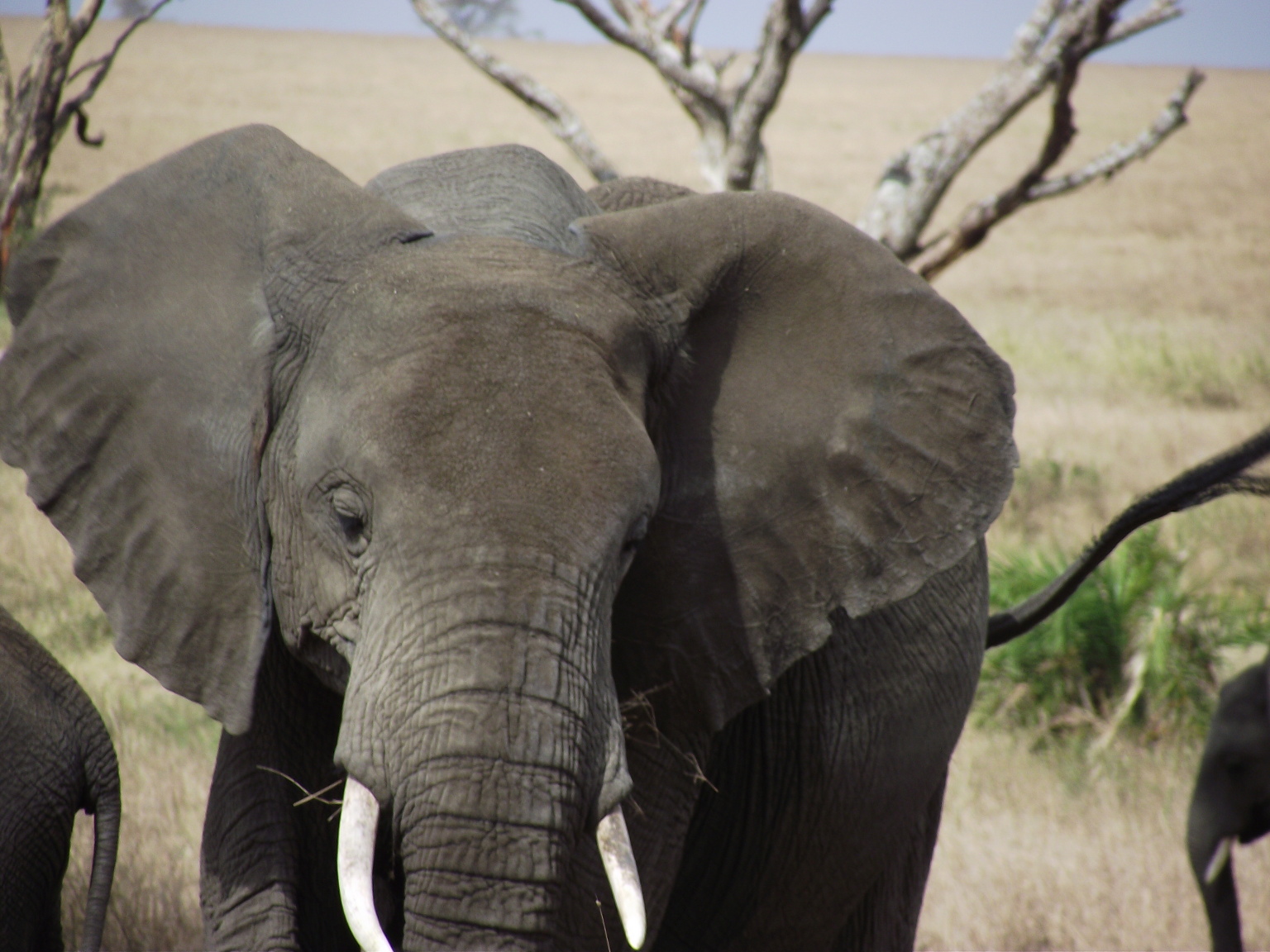 African elephants. Is there a more iconic animal? One of the big five. The animals everyone loves and really wants to see. We saw lots of elephants. I was frankly amazed at how many elephants
were wondering around the Serengeti. I had the impression they were going to be rare and hard to find before going there. Not so. The elephant population, at least in the areas we traveled through,
seems to be quite large. We saw lots of babies and juvenile elephants too. So they seem to be reproducing at a good rate. That's really great. They are amazing animals. We spent a lot of time
watching them as they went about their business.
African elephants. Is there a more iconic animal? One of the big five. The animals everyone loves and really wants to see. We saw lots of elephants. I was frankly amazed at how many elephants
were wondering around the Serengeti. I had the impression they were going to be rare and hard to find before going there. Not so. The elephant population, at least in the areas we traveled through,
seems to be quite large. We saw lots of babies and juvenile elephants too. So they seem to be reproducing at a good rate. That's really great. They are amazing animals. We spent a lot of time
watching them as they went about their business.
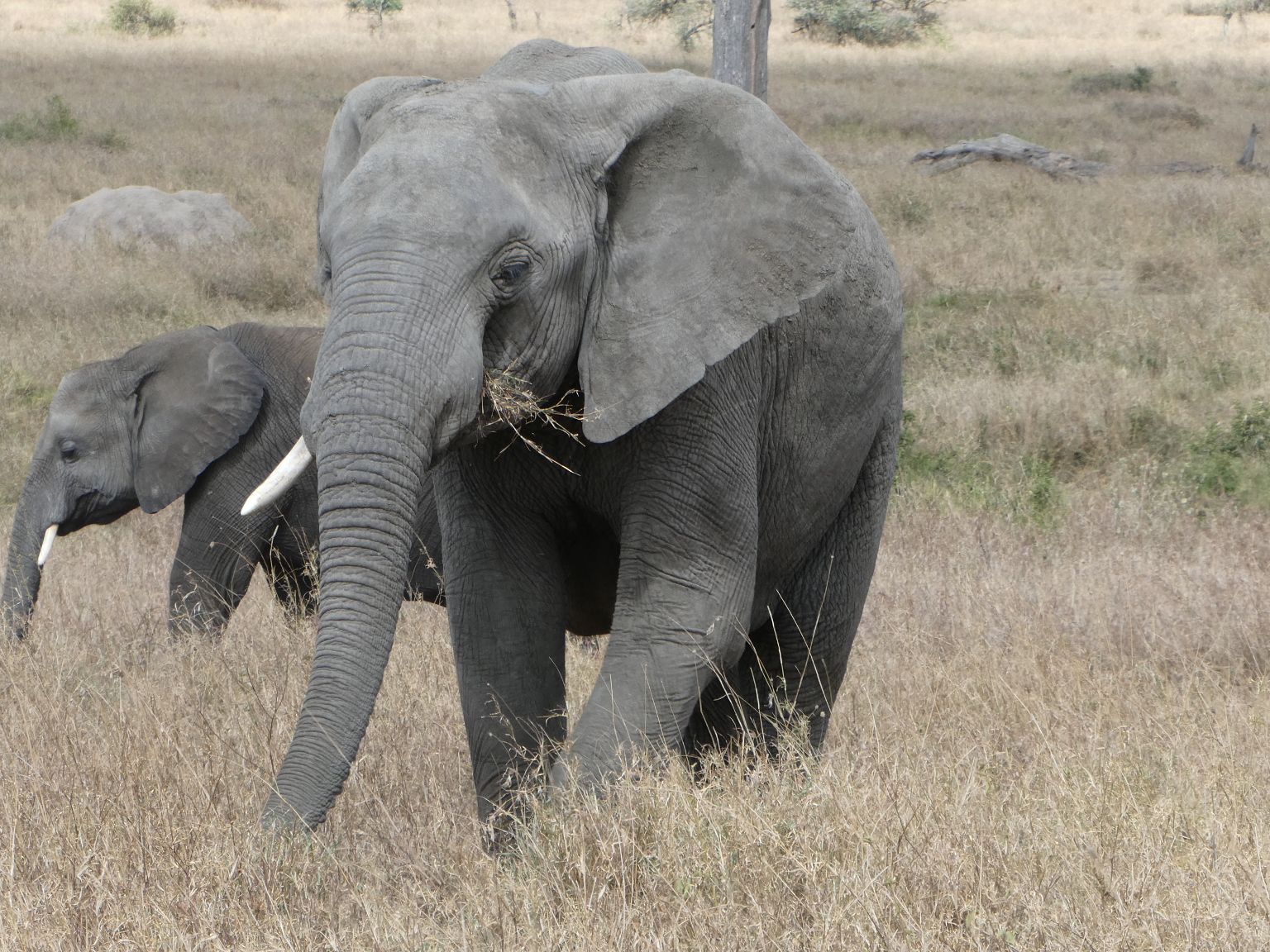 This female elephant is missing a tusk. Our guide suspected she likely broke it off while using it for digging. He said it could possibly grow back as long as the root wasn't damaged.
This female elephant is missing a tusk. Our guide suspected she likely broke it off while using it for digging. He said it could possibly grow back as long as the root wasn't damaged.
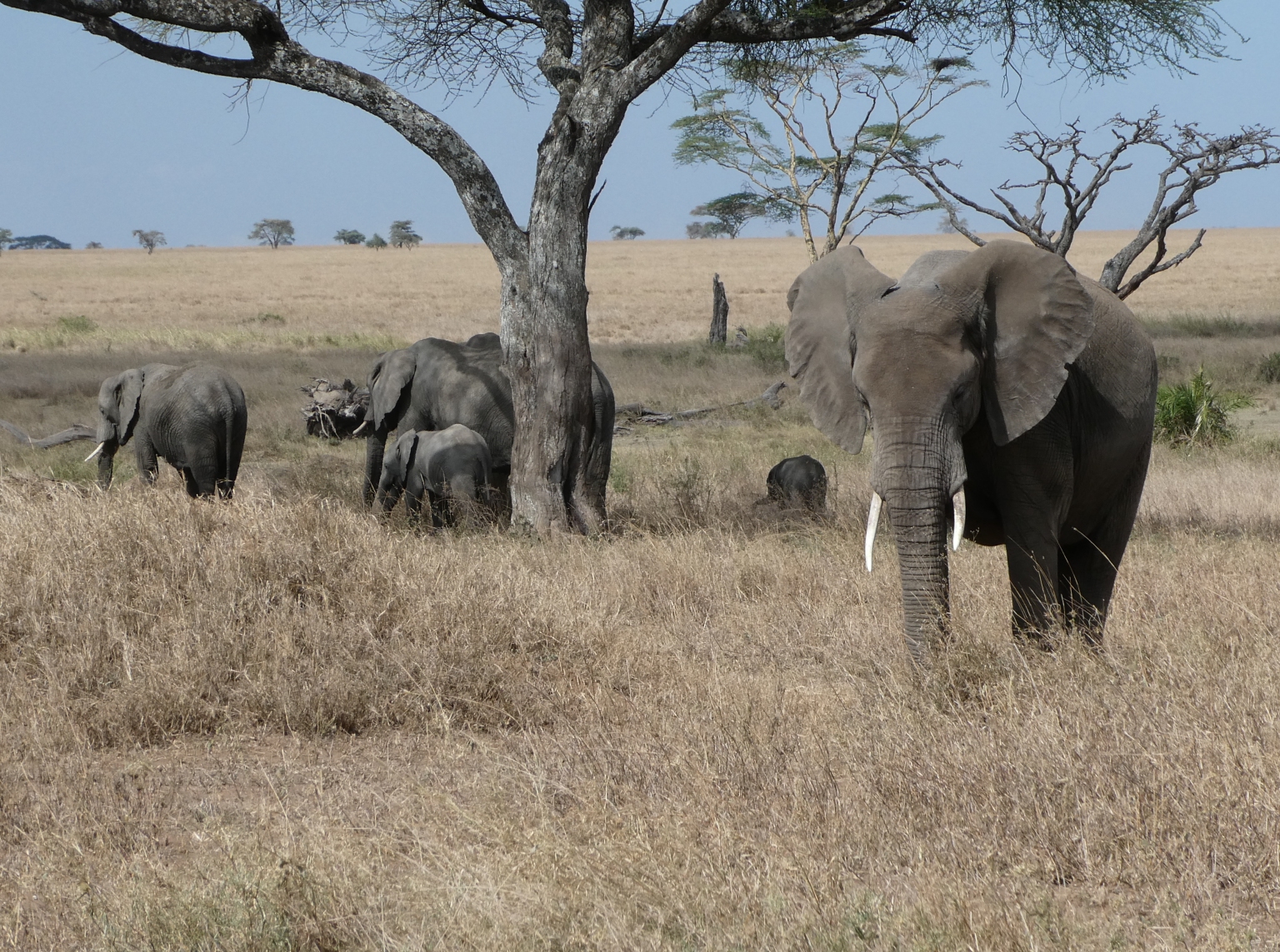 I lost count of how many large herds of elephants we saw. The herds usually consist of adult females and juveniles of both sexes. The herds are led by a big old matriarch female. They run off the
males when they get to 12 or 13 years old because they start getting too aggressive and are a danger to the babies in the herd. The males congregate in bachelor herds or roam solitary.
We saw a few solitary big old bull male elephants, but they were always too far away to get good photos. We also saw one group of young adult males. We saw a lot of elephants.
I lost count of how many large herds of elephants we saw. The herds usually consist of adult females and juveniles of both sexes. The herds are led by a big old matriarch female. They run off the
males when they get to 12 or 13 years old because they start getting too aggressive and are a danger to the babies in the herd. The males congregate in bachelor herds or roam solitary.
We saw a few solitary big old bull male elephants, but they were always too far away to get good photos. We also saw one group of young adult males. We saw a lot of elephants.
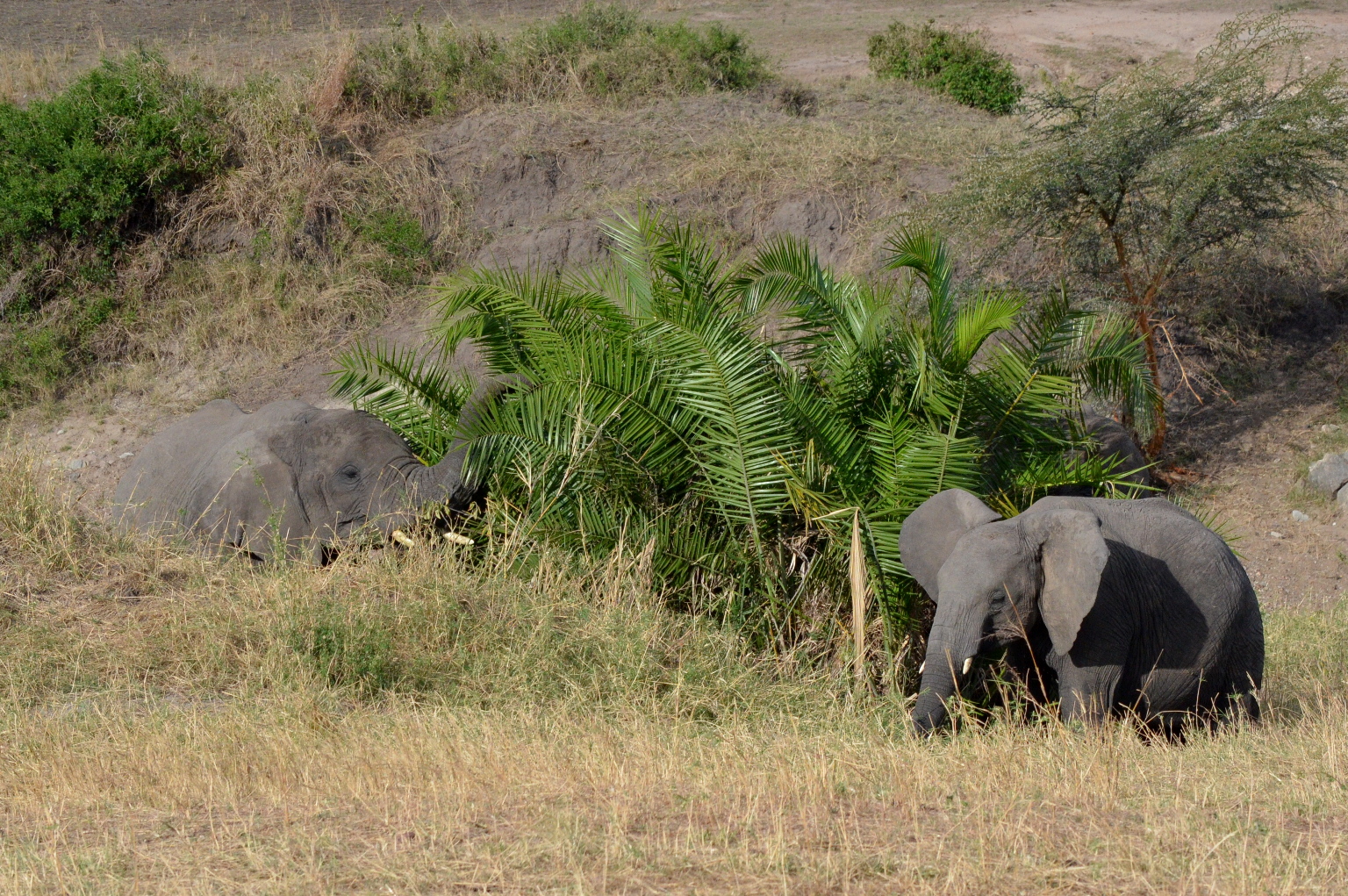 Elephants love eating palm trees. We saw them munching on palm trees on several occasions. They can really decimate a grove of palm trees. This is ironic since my fiancee owns a palm
tree nursery. We joked with her about letting a few elephants loose in it. NO!!!! was her response.
Elephants love eating palm trees. We saw them munching on palm trees on several occasions. They can really decimate a grove of palm trees. This is ironic since my fiancee owns a palm
tree nursery. We joked with her about letting a few elephants loose in it. NO!!!! was her response.
Here is a video of a large group of elephants coming down to the Mara river for a morning drink, and then deciding to cross the river. We first spotted the elephants far away on the far side of
the river, coming out of the trees. They slowly meandered their way down to the river, eating as they went. Then we got lucky enough to see them cross. This video is about nine minutes long,
but it is several short segments edited together taken as we watched the elephants slowly make their way down to, and across the river. We watched them for a long time. They were amazing to
watch as they did their thing, totally free and wild. So much more interesting than animals in zoos. Even our guide who has been doing this for 15 years was quite excited to see such a large
group of elephants cross the river.
Giraffe
 Giraffes are another of the iconic animals of Africa. Boy did we see a lot of giraffes. Unlike most of the animals on this page, we saw giraffes even well outside of the wildlife parks.
Just about anywhere there were acacia trees and it's not too urban, there were giraffes. We started seeing them our first day in the bush while we were visiting archaeological sites and
Maasai villages, long before even getting to the Serengeti proper. We saw giraffes from the little bush planes we took hopping from airstrip to airstrip. We saw them beside the airstrips
while taking off and landing, and we saw them from the air while flying over the bush. Giraffes are just about everywhere, but they don't congregate in large numbers like a lot of other
animals. you'll see them in ones and twos. I think five in the same general area was about the biggest group of giraffes we ever saw. However, they were so common that you might see some
in the backgrounds of some of the other photos in this page if you look closely.
Giraffes are another of the iconic animals of Africa. Boy did we see a lot of giraffes. Unlike most of the animals on this page, we saw giraffes even well outside of the wildlife parks.
Just about anywhere there were acacia trees and it's not too urban, there were giraffes. We started seeing them our first day in the bush while we were visiting archaeological sites and
Maasai villages, long before even getting to the Serengeti proper. We saw giraffes from the little bush planes we took hopping from airstrip to airstrip. We saw them beside the airstrips
while taking off and landing, and we saw them from the air while flying over the bush. Giraffes are just about everywhere, but they don't congregate in large numbers like a lot of other
animals. you'll see them in ones and twos. I think five in the same general area was about the biggest group of giraffes we ever saw. However, they were so common that you might see some
in the backgrounds of some of the other photos in this page if you look closely.
 Giraffes with their long legs and long necks are specialized for feeding from the tops of acacia trees. So where there are acacia trees, you will usually find giraffes. Where there
are giraffes, you will always find acacia trees. They have long tongues that they use to wrap around the acacia twigs and strip off the leaves. Acacia trees are covered with long,
sharp and extremely wicked thorns. I got caught up in acacia thorns several times on our trip. It's no fun. Somehow the thorns don't bother the giraffes at all.
Giraffes with their long legs and long necks are specialized for feeding from the tops of acacia trees. So where there are acacia trees, you will usually find giraffes. Where there
are giraffes, you will always find acacia trees. They have long tongues that they use to wrap around the acacia twigs and strip off the leaves. Acacia trees are covered with long,
sharp and extremely wicked thorns. I got caught up in acacia thorns several times on our trip. It's no fun. Somehow the thorns don't bother the giraffes at all.
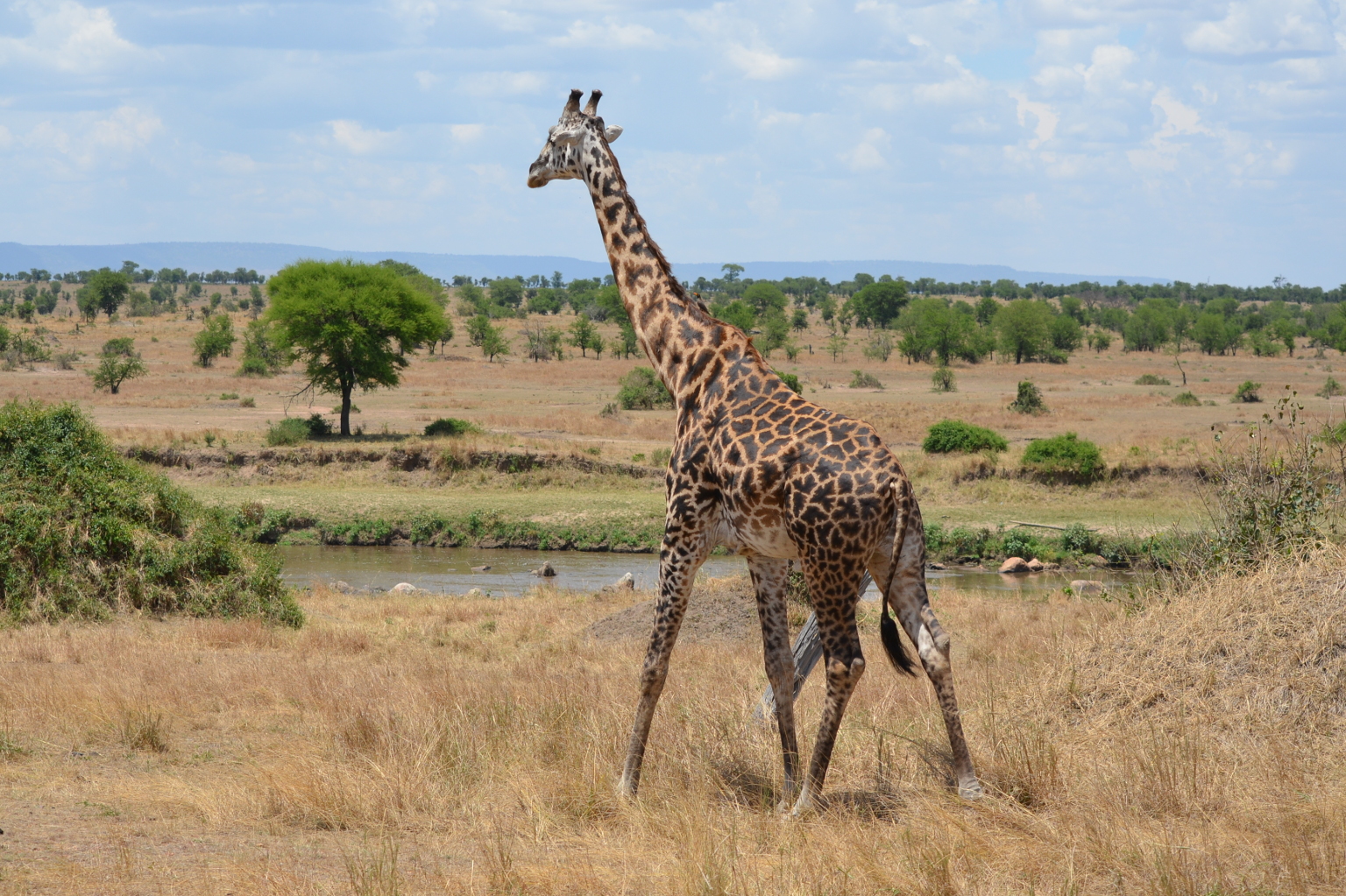 The particular sub-species of giraffe we saw in the areas we passed through is known as the Maasai Giraffe. The coat pattern is particularly striking and beautiful I think. This particular
giraffe has an ox pecker bird riding along on its neck. That was quite a common sight with the giraffes, and in fact most of the large grazing animals.
The particular sub-species of giraffe we saw in the areas we passed through is known as the Maasai Giraffe. The coat pattern is particularly striking and beautiful I think. This particular
giraffe has an ox pecker bird riding along on its neck. That was quite a common sight with the giraffes, and in fact most of the large grazing animals.
Here is a fairly close-up video of a giraffe eating the leaves of an acacia tree. The acacia trees are covered with very long and sharp thorns. The giraffes don't seem to be bothered by them at all as they use their long tongues to strip the leaves off the acacia trees. A lot of the giraffes we saw were a little shy and wary of us. Few allowed us to get this close. We were lucky to see this fellow so close-up.
My voice sounds a little muffled in this and some of the other videos because I am wearing a muff over my mouth and nose due to the dust on the roads kicked up as we drove around the Serengeti. Dust covered us and our camera equipment and our binoculars. We'd return to camp after a full day out in the safari truck and just be covered in dust. The water would run brown when we took a shower in the evening.
Hippo
Here is a video of a group of hippos tustling and fighting in a tributary of the Mara River. We watched them for a long time as they continually pushed and shoved each other and jockeyed
for position. I guess it was probably all about dominance and who is the boss and establishing the pecking order.
Hippos are really smelly animals. You can usually smell them long before you see them. Slow moving streams with lots of hippos in them get clogged with lots of hippo dung. What a smelly mess.
Here we saw a group of hippos out of the water at midday. That is sort of unusual. The hippos usually stay in the water during the heat of the day and come out at night to feed on grass.
It was nice to be able to get a look at them out of the water.
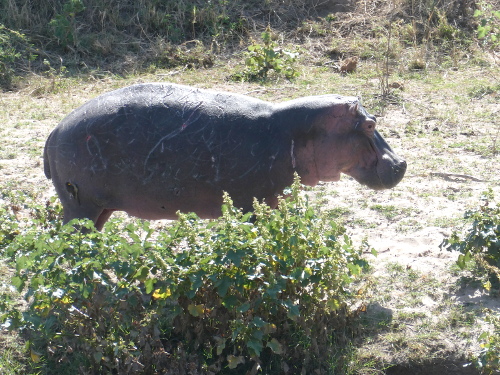 Here is a photo of a scarred up old hippo out of the water. It was early morning and not all the hippos had returned to the water yet after feeding on grass all night. This old fellow
is just covered with scars on his flanks. After seeing how the hippos constantly seem to tustle and fight in the water, I know how he got all those scars.
Here is a photo of a scarred up old hippo out of the water. It was early morning and not all the hippos had returned to the water yet after feeding on grass all night. This old fellow
is just covered with scars on his flanks. After seeing how the hippos constantly seem to tustle and fight in the water, I know how he got all those scars.
Predators
Cheetah
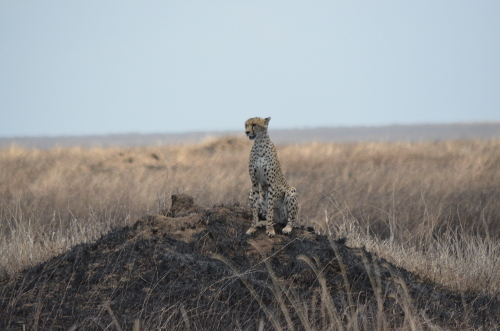 Here is a cheetah sitting on top of a termite mound and surveying the plains for something to hunt. Our first day in Serengeti National Park was very productive. We were barely
through the entrance gate and we saw our first lions, a spotted hyena, an eagle, and then a little further down the road, this cheetah. And all that was in like the first hour in the park.
We were actually quite lucky to see this cheetah. They are among the rarest of the the big cats. It was just sitting there, surveying the horizon for something to catch for lunch.
It was totally unconcerned about us and happily posed for lots of photos.
Here is a cheetah sitting on top of a termite mound and surveying the plains for something to hunt. Our first day in Serengeti National Park was very productive. We were barely
through the entrance gate and we saw our first lions, a spotted hyena, an eagle, and then a little further down the road, this cheetah. And all that was in like the first hour in the park.
We were actually quite lucky to see this cheetah. They are among the rarest of the the big cats. It was just sitting there, surveying the horizon for something to catch for lunch.
It was totally unconcerned about us and happily posed for lots of photos.
Crocodile
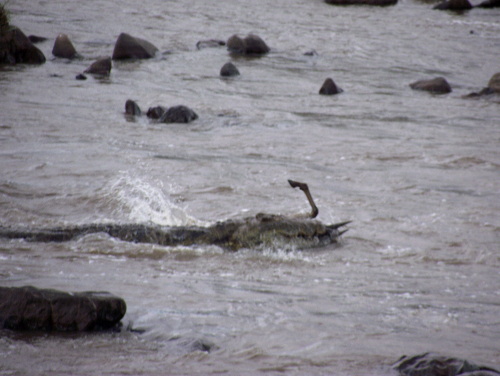 Ok, I know there is a separate reptiles section on this page. However, I am putting
the Nile Crocodiles here in the predators section after seeing a monster croc take down a nearly full grown wildebeest like it was nothing. The wildebeest was nearly the size of a cow and
the croc opened it's jaws as wide as a barn door and took it down in a heartbeat. That crock must be 4-5 meters long. It was an absolute monster.
Ok, I know there is a separate reptiles section on this page. However, I am putting
the Nile Crocodiles here in the predators section after seeing a monster croc take down a nearly full grown wildebeest like it was nothing. The wildebeest was nearly the size of a cow and
the croc opened it's jaws as wide as a barn door and took it down in a heartbeat. That crock must be 4-5 meters long. It was an absolute monster.
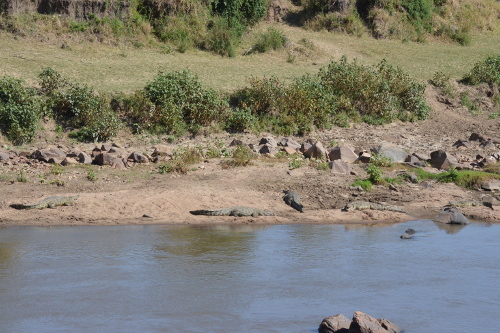 Here is a photo of four huge Nile Crocodiles basking on the shore of the Mara River in Tanzania. Trust me on this. You really, really don't
want to go swimming in the Mara River.
Here is a photo of four huge Nile Crocodiles basking on the shore of the Mara River in Tanzania. Trust me on this. You really, really don't
want to go swimming in the Mara River.
Fox
 Here is a bat-eared fox. Unfortunately we only saw one of these cute little foxes, and this is the best photo we got of it.
Here is a bat-eared fox. Unfortunately we only saw one of these cute little foxes, and this is the best photo we got of it.
Hyena
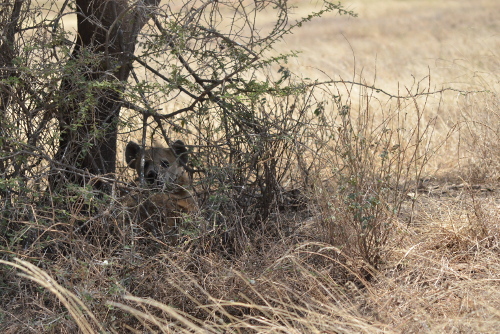 A spotted hyena hiding in the shade under a bush. We were barely through the gate of Serengeti national Park and had stopped to get a photo of an eagle in a tree when our guide spotted
the hyena in its hiding place.
A spotted hyena hiding in the shade under a bush. We were barely through the gate of Serengeti national Park and had stopped to get a photo of an eagle in a tree when our guide spotted
the hyena in its hiding place.
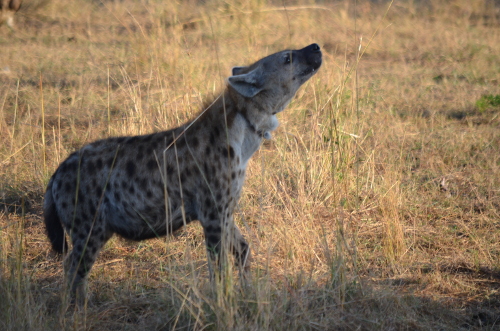 Here is a nice close-up of a spotted hyena. We heard hyenas all night every night while in our tents. We only rarely saw them during the day.
Here is a nice close-up of a spotted hyena. We heard hyenas all night every night while in our tents. We only rarely saw them during the day.
One morning our guide suggested we get an early start and get out in the bush before dawn. He said we'd see things we don't ordinarily see during the heat of the day. We could also
enjoy seeing sunrise on the Serengeti and have a picnic breakfast in the bush. It was an irresistible offer. So we got up before dawn and hurriedly got ready to go. We bundled into
his safari truck and hit the Serengeti before dawn. Sunrise was magnificent.
We were looking for a good picnic spot for breakfast when a spotted hyena came running across our path in a really big hurry to get somewhere. We could also hear some kind of commotion
off in the far distance in the bush. Our guide said we should follow the hyena and it would likely lead us to something interesting. So we turned off the road and went crashing through
the bush, following the hyena and trying to keep it in sight. We had to stop and look and listen a couple of times as we lost sight of him in the bush. Eventually it led us to a bunch
of other hyenas feeding at a wildebeest kill. There were also black-backed jackals and lots of vultures at the kill. We watched the animals thoroughly dismember the wildebeest for quite
a while.
There were a lot of other hyenas about that don't show up in the video. They were circling around at a goodly distance forming a perimeter around the kill. They had likely already eaten
their fill and we were seeing the late arrivals eating the leftovers. The hyenas have incredibly powerful jaws. We could hear them cracking open the bones to get at the marrow.
Jackals would dart in and snatch a piece here and there. Our guide suspected that lions had originally killed
the wildebeest and the hyenas and jackals came across the remains after the lions left. They kept looking around as if afraid the lions would come back. A couple of times they got
spooked and ran off for a few minutes before returning. While they were gone the vultures would take the opportunity to pounce on the carcass.
Jackal
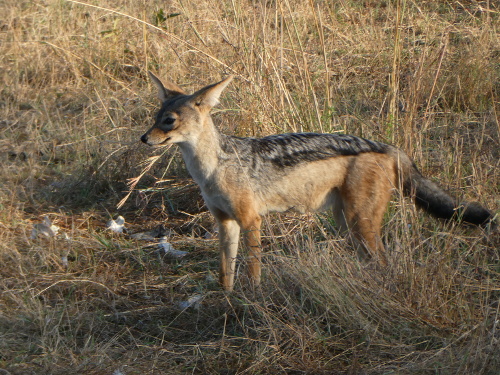 Here is a black-backed jackal. They are about the size of a fox or small dog. They are some of the handsomest animals we saw. We only rarely saw them though.
Here is a black-backed jackal. They are about the size of a fox or small dog. They are some of the handsomest animals we saw. We only rarely saw them though.
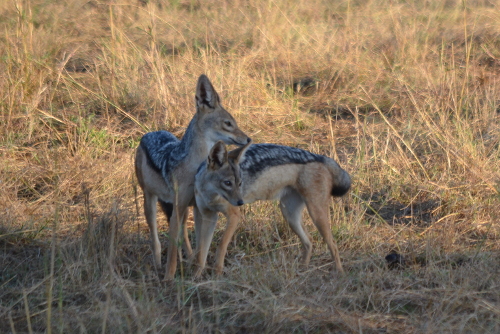 Here is a photo of a couple more black-backed jackals. I think they were some of the cutest animals we saw in Africa.
Here is a photo of a couple more black-backed jackals. I think they were some of the cutest animals we saw in Africa.
Leopard
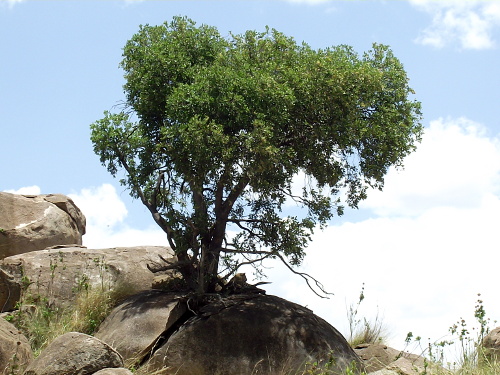 Our guide knew the leopard was hiding somewhere in an area of large rocks and boulders called a kopje.
We drove around looking for him for an hour before finally spotting him. He was well hidden, on top of a rock and in the dark shade of a sausage tree. He was only visible from one place
through a gap in the surrounding rocks, and really only noticeable when he
moved. This was our initial view of him when our guide first spotted him. Then we pulled out the telephoto lenses.
Our guide knew the leopard was hiding somewhere in an area of large rocks and boulders called a kopje.
We drove around looking for him for an hour before finally spotting him. He was well hidden, on top of a rock and in the dark shade of a sausage tree. He was only visible from one place
through a gap in the surrounding rocks, and really only noticeable when he
moved. This was our initial view of him when our guide first spotted him. Then we pulled out the telephoto lenses.
 Here's a really great photo of the leopard my fiancee took. It was just sitting there in the shade, without a care in the world. We took lots of photos. Leopards are elusive. We didn't
know if we'd see any more.
Here's a really great photo of the leopard my fiancee took. It was just sitting there in the shade, without a care in the world. We took lots of photos. Leopards are elusive. We didn't
know if we'd see any more.
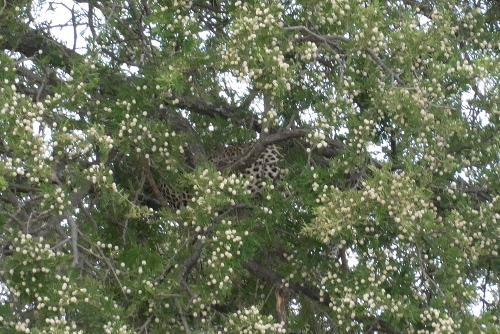 We were driving down a road in Serengeti National Park and saw some other safari trucks stopped and people were looking up in a sausage tree. We stopped too and looked and saw what
they were looking at. It was a leopard sleeping up in the tree. It was barely visible. We could just see some of it's spots through the leaves and flowers.
We were driving down a road in Serengeti National Park and saw some other safari trucks stopped and people were looking up in a sausage tree. We stopped too and looked and saw what
they were looking at. It was a leopard sleeping up in the tree. It was barely visible. We could just see some of it's spots through the leaves and flowers.
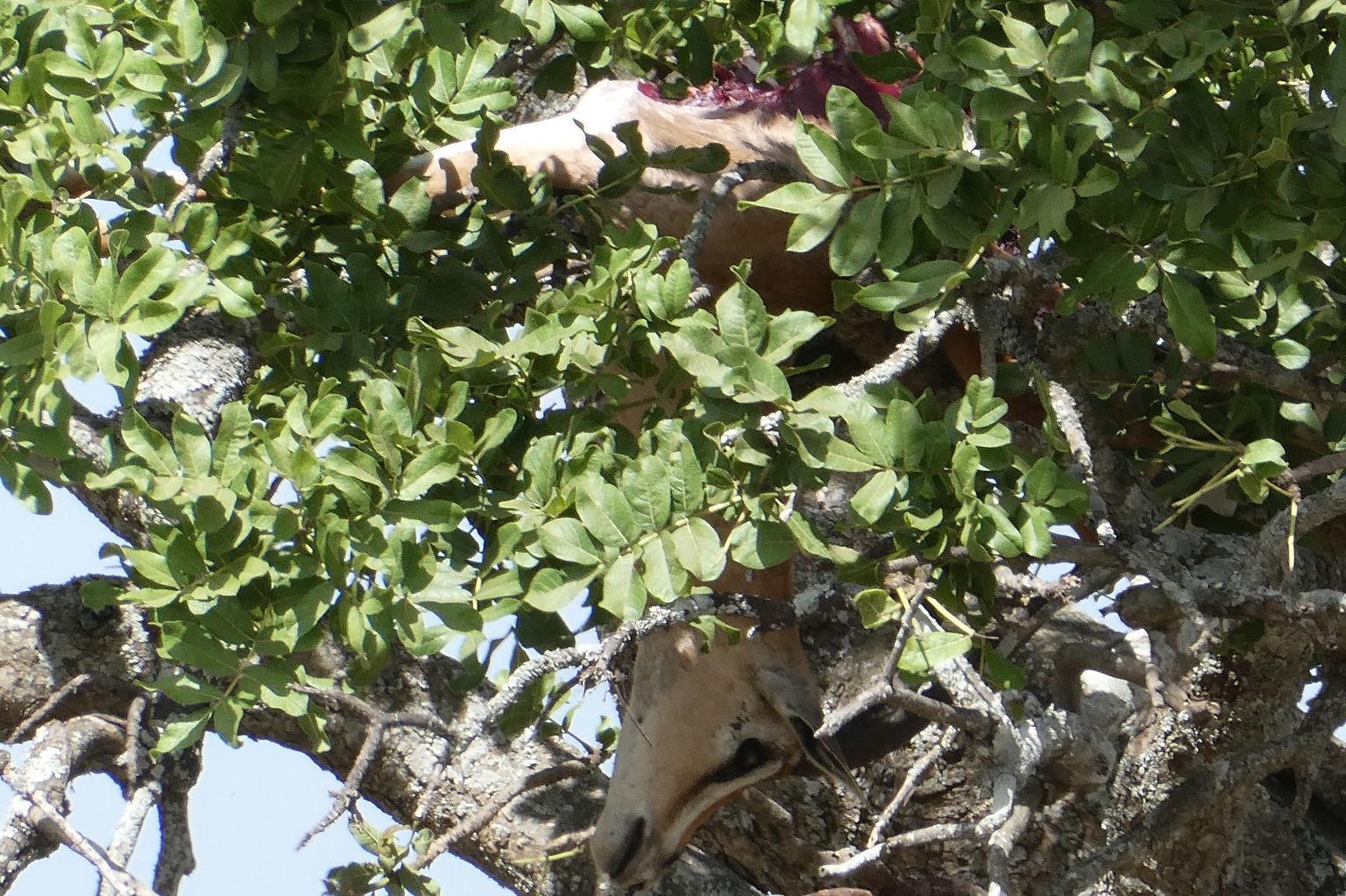 After we got a few photos of the above leopard in the tree, we took off down the road again. After a short distance our guide hit the brakes and put the truck in reverse. "I think I saw something
red up in that tree," he said. He pulled out his binoculars, looked, and then backed the truck up further so we could see. About three trees away from the sleeping leopard we found his larder.
He had dragged a dead Thompson's gazelle up into the tree and had been feeding on the carcass.
After we got a few photos of the above leopard in the tree, we took off down the road again. After a short distance our guide hit the brakes and put the truck in reverse. "I think I saw something
red up in that tree," he said. He pulled out his binoculars, looked, and then backed the truck up further so we could see. About three trees away from the sleeping leopard we found his larder.
He had dragged a dead Thompson's gazelle up into the tree and had been feeding on the carcass.
Lion
Here is a brief video of a male lion. We only saw two male lions on the whole eight day safari, and this is the only one we got a close look at and decent pictures of. We had been waiting
for hours for a huge herd of thousands of wildebeest to start crossing the river. More and more were pouring into a small area on the river bank and the pressure of their sheer numbers
would have eventually pushed them to start crossing. Then this old boy broke cover and trotted out into the open. Thousands of wildebeest turned tail and ran for the horizon in a huge
stampede. Leaving behind an empty plain and a big dust cloud. With nothing left for him to hunt, he laid down in the shade and let us tourists get within 20 feet of him to get some closeup
photos.
This video was shot very close to the Kogatende Airstrip. That explains the loud aircraft noise in the background and the presence of other vehicles. Kogatende Airstrip is a dirt airstrip
deep in the bush. It's the airstrip we flew out of the next day after this video was shot. There were several hops from airstrip to airstrip in tiny, rugged bush planes on this trip.
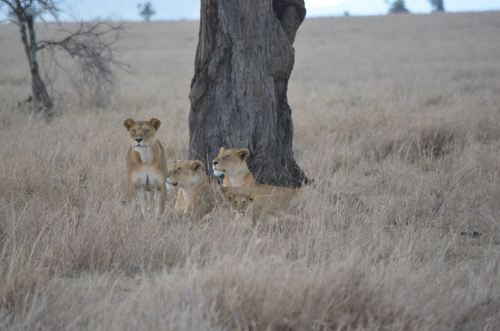 Here's a sweet photo of a group of three lionesses and a kitten. I have video of this family group too. See below.
Here's a sweet photo of a group of three lionesses and a kitten. I have video of this family group too. See below.
Here's a video of the above three lionesses and a kitten. A really cute family group. Later one of the lionesses got up and walked a short distance away and laid
down in the tall grass becoming completely invisible. This was a pattern we saw several times among groups of lions. Several would be lazing away in the open,
seemingly without a care, but there would be one well hidden, awake and alert nearby, watching.
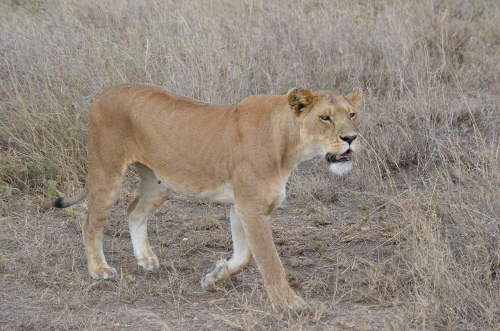 Here is a photo of a lioness who walked over to our safari truck and allowed us to get some really good photos of her. I don't think she was actually interested in us. She appeared to want to see
what was going on out of view behind our truck. After scanning the savanna behind us, she walked back to where she was and laid down.
Here is a photo of a lioness who walked over to our safari truck and allowed us to get some really good photos of her. I don't think she was actually interested in us. She appeared to want to see
what was going on out of view behind our truck. After scanning the savanna behind us, she walked back to where she was and laid down.
 Our guide described it as "a pile of lions" sleeping the day away in the shade. This photo shows three lions sleeping out in the open. Nearby there were too more, and a little further away another
three, and those are just the ones we saw. No doubt there were more. It was quite a large pride.
Our guide described it as "a pile of lions" sleeping the day away in the shade. This photo shows three lions sleeping out in the open. Nearby there were too more, and a little further away another
three, and those are just the ones we saw. No doubt there were more. It was quite a large pride.
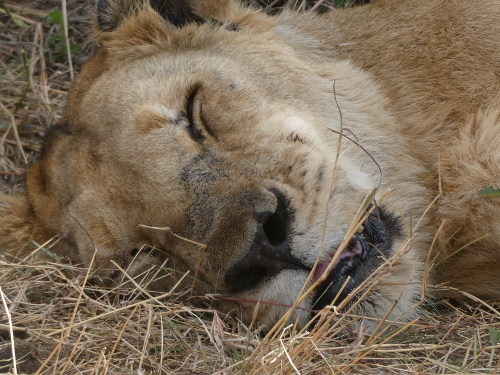 My fiancee got a really great close-up shot of one of the sleeping lions. I really like this picture.
My fiancee got a really great close-up shot of one of the sleeping lions. I really like this picture.
 As we saw other times with lions, while most would be sleeping out in the open, seemingly without a care, there would be one hidden somewhere, awake and alert, and watching. As we moved the safari
truck away from the above sleeping "pile of lions," we spotted the guard lion hiding nearby, down in the creek. She was invisible to us until we moved.
As we saw other times with lions, while most would be sleeping out in the open, seemingly without a care, there would be one hidden somewhere, awake and alert, and watching. As we moved the safari
truck away from the above sleeping "pile of lions," we spotted the guard lion hiding nearby, down in the creek. She was invisible to us until we moved.
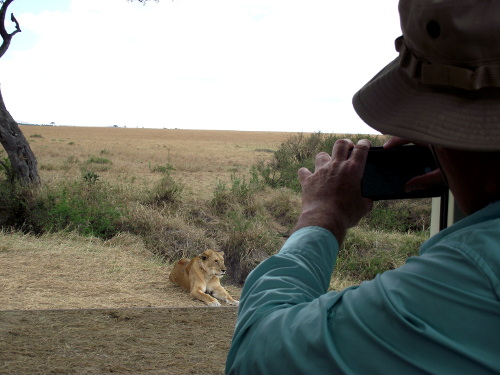 One question I get a lot from people is, "How close did you get to the lions?" This photo should help answer that question. Mary took this photo of me taking a photo of a lion out the
safari truck window. Note that I am using my phone to take the picture, not my Nikon camera with the big, long telephoto lens. Don't get me wrong, the telephoto lens got used a lot, but often
we were very close to the animals, and not just the lions. Most of the animals completely ignored our presence. Elephants, zebras, wildebeest, many kinds of antelope and lions often
walked right past our safari truck so close we could (almost) reach out and touch them. If we stayed parked in one place for a while, and stayed quiet and still, the animals would
go about their business around us as if we weren't even there.
One question I get a lot from people is, "How close did you get to the lions?" This photo should help answer that question. Mary took this photo of me taking a photo of a lion out the
safari truck window. Note that I am using my phone to take the picture, not my Nikon camera with the big, long telephoto lens. Don't get me wrong, the telephoto lens got used a lot, but often
we were very close to the animals, and not just the lions. Most of the animals completely ignored our presence. Elephants, zebras, wildebeest, many kinds of antelope and lions often
walked right past our safari truck so close we could (almost) reach out and touch them. If we stayed parked in one place for a while, and stayed quiet and still, the animals would
go about their business around us as if we weren't even there.
Of all the animals, I think only the lions were ever so slightly annoyed by our presence, and then only because our safari truck blocked their view. They'd occasionally have to get up and walk
around us to have a good look around the savanna behind our truck. The lions may seem lazy, but they liked to be aware of their surroundings, especially if there were kittens in the pride.
Mongoose
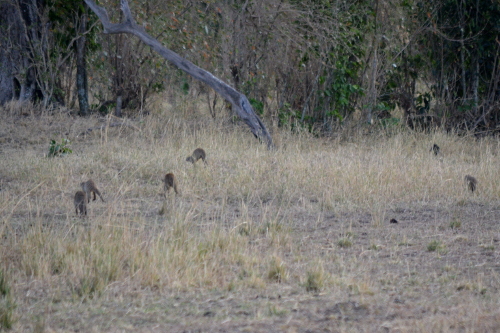 We saw mongoose on several occasions. Unfortunately they were always far away and running away from us. So we never got any good photos of them, or even really figured out which species of
the four or five found in Africa that they were.
We saw mongoose on several occasions. Unfortunately they were always far away and running away from us. So we never got any good photos of them, or even really figured out which species of
the four or five found in Africa that they were.
Grazers
Dik-dik
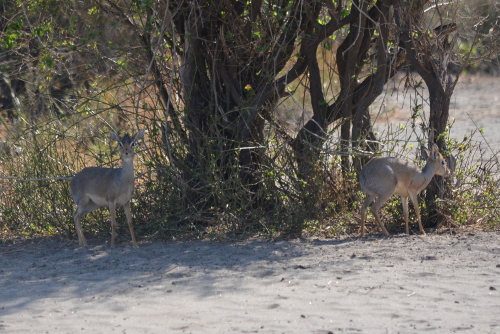 A pair of dik-diks hiding in the shade of a bush. Dik-diks are tiny little antelope, about the size of small dogs. They are almost always seen in mated male/female pairs. They were quite shy
and usually ran off into the bush before we could get good photos of them.
A pair of dik-diks hiding in the shade of a bush. Dik-diks are tiny little antelope, about the size of small dogs. They are almost always seen in mated male/female pairs. They were quite shy
and usually ran off into the bush before we could get good photos of them.
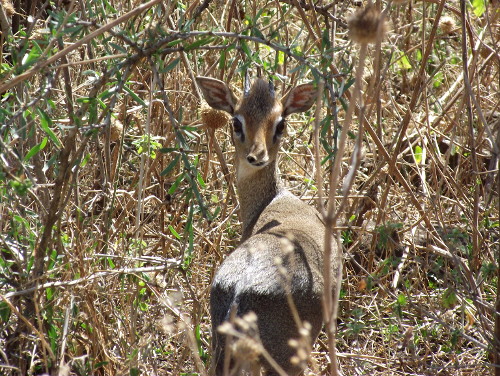 Here is a close-up of a dik-dik. We saw a lot of dik-diks, but never in large groups. I think the largest group of dik-diks we saw was only three.
Here is a close-up of a dik-dik. We saw a lot of dik-diks, but never in large groups. I think the largest group of dik-diks we saw was only three.
Eland
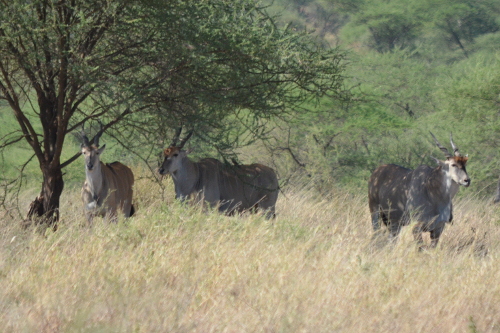 Here is a photo of a group of Common Eland. Eland's are very large antelope. From a distance they greatly resemble cattle, but are true antelope.
Here is a photo of a group of Common Eland. Eland's are very large antelope. From a distance they greatly resemble cattle, but are true antelope.
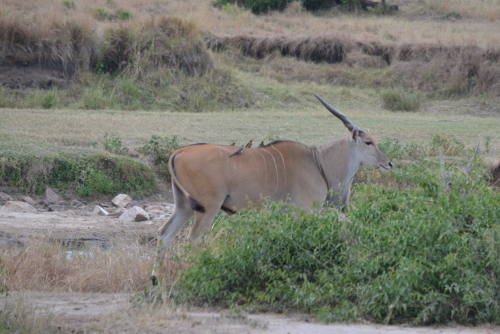 Here is a photo of an Eland that shows the vertical stripes on its flanks and spiral horns. It also has a bunch of ox pecker birds riding on its back.
Here is a photo of an Eland that shows the vertical stripes on its flanks and spiral horns. It also has a bunch of ox pecker birds riding on its back.
Grant's Gazelle
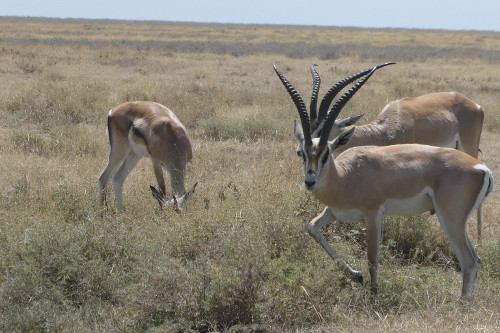 The Grant's gazelle is a medium size antelope. They are fairly common, but not as common as the smaller Thompson's gazelle. The Grant's were almost always mixed in with the more numerous
Thompson's. I think every photo we have of Grant's gazelles has a Thompson's or two in it.
The Grant's gazelle is a medium size antelope. They are fairly common, but not as common as the smaller Thompson's gazelle. The Grant's were almost always mixed in with the more numerous
Thompson's. I think every photo we have of Grant's gazelles has a Thompson's or two in it.
Here is a photo of two male Grant's gazelles on the right with a female Thopmson's on the left.
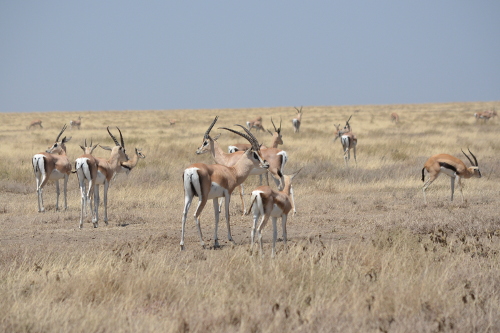 Here is a photo of a mixed herd of Grant's and Thompson's gazelles. The Grant's are in the foreground. The main difference between the two species aside from the Grant's being larger,
is that they also lack the prominent black stripe that the Thompson's have on their sides.
Here is a photo of a mixed herd of Grant's and Thompson's gazelles. The Grant's are in the foreground. The main difference between the two species aside from the Grant's being larger,
is that they also lack the prominent black stripe that the Thompson's have on their sides.
Both species prefer the open, short grass areas of the Serengeti. They follow behind the herds of larger migrating animals as they crop the long grass short.
Hartebeest
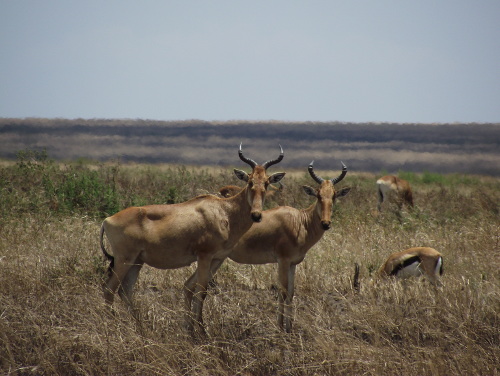 Here is a pair of Hartebeest, another large species of antelope. From a distance their ears look like a second set of horns. We didn't get very many close-up photos of Hartebeest,
even though we saw a lot of them. They were always just a little too far away to get good pictures. Fortunately Mary saw an opportunity and snapped this great close-up photo of a pair of them.
Here is a pair of Hartebeest, another large species of antelope. From a distance their ears look like a second set of horns. We didn't get very many close-up photos of Hartebeest,
even though we saw a lot of them. They were always just a little too far away to get good pictures. Fortunately Mary saw an opportunity and snapped this great close-up photo of a pair of them.
Impala
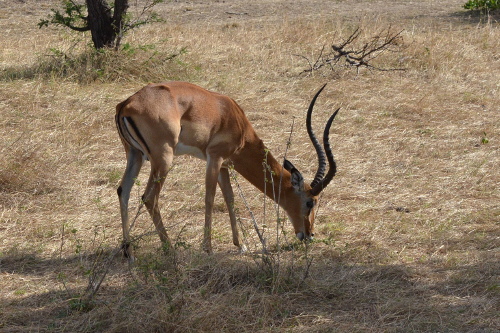 Impalas are medium-size antelope. They live in groups of either one dominant mail and a large harem of females, or groups of bachelor males with no harem. We saw both kinds of groups.
Here is a magnificent male impala. Below is a photo of his harem of females. The impalas tended to be rather shy and and to keep their distance from us. We were lucky to get so close to
this fellow to get such a good photo.
Impalas are medium-size antelope. They live in groups of either one dominant mail and a large harem of females, or groups of bachelor males with no harem. We saw both kinds of groups.
Here is a magnificent male impala. Below is a photo of his harem of females. The impalas tended to be rather shy and and to keep their distance from us. We were lucky to get so close to
this fellow to get such a good photo.
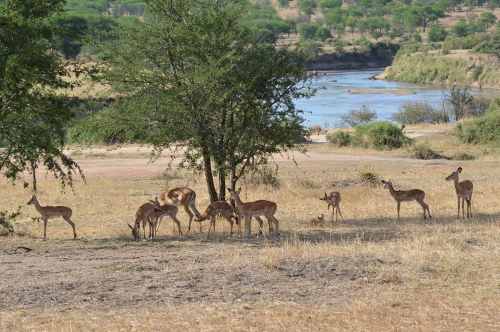 Here is a harem of female impalas belonging to the above male. The females we saw usually wouldn't get too close to us and usually didn't stray too far from cover.
Here is a harem of female impalas belonging to the above male. The females we saw usually wouldn't get too close to us and usually didn't stray too far from cover.
Klipspringer
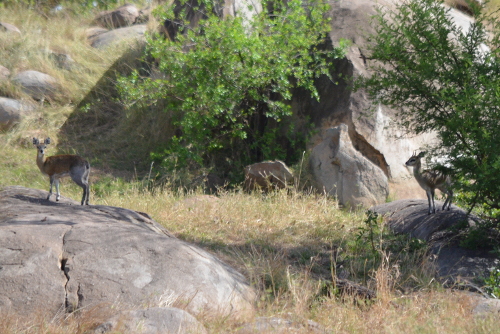 Klipspringers are small antelope, about the size of Dik-diks or small dogs. They have hooves specialized for climbing on rocks. Klipspringers are almost always seen standing on rocks.
We didn't see many klipspringers since they are mostly nocturnal animals.
Klipspringers are small antelope, about the size of Dik-diks or small dogs. They have hooves specialized for climbing on rocks. Klipspringers are almost always seen standing on rocks.
We didn't see many klipspringers since they are mostly nocturnal animals.
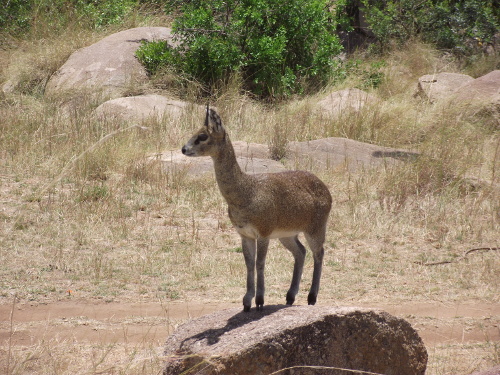 Here is a close-up of a klipspringer standing on a rock. I don't think we ever saw one that wasn't standing on a rock. They must come down to graze sometime.
Here is a close-up of a klipspringer standing on a rock. I don't think we ever saw one that wasn't standing on a rock. They must come down to graze sometime.
Steenbok
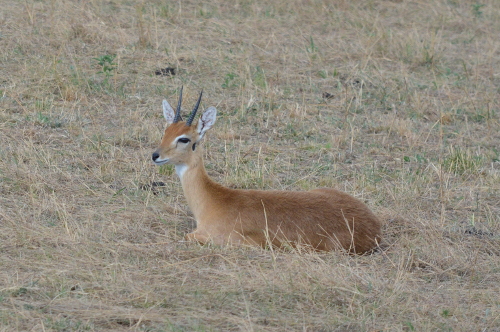 Steenboks are another species of small antelope, about the size of a Dik-dik or a small dog. We saw a few of these very cute antelope, usually laying in the grass and pretty much ignoring us.
Steenboks are another species of small antelope, about the size of a Dik-dik or a small dog. We saw a few of these very cute antelope, usually laying in the grass and pretty much ignoring us.
Thomson's gazelle
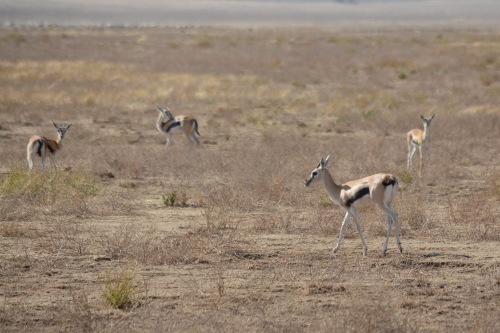 Thompson's gazelles are small antelope, a little larger than Dik-diks, with longer legs. Thompson's are among the most numerous of all the antelope. We saw them in huge herds, as well as just
small groups of only a few animals. They prefer the open, short, dry grass areas of the Serengeti, likely so they can more easily see any predators creeping up on them. They follow behind other larger
migrating animals who crop the grass short for them. They are the last migrating animals to arrive an an area, and the last to leave.
Thompson's gazelles are small antelope, a little larger than Dik-diks, with longer legs. Thompson's are among the most numerous of all the antelope. We saw them in huge herds, as well as just
small groups of only a few animals. They prefer the open, short, dry grass areas of the Serengeti, likely so they can more easily see any predators creeping up on them. They follow behind other larger
migrating animals who crop the grass short for them. They are the last migrating animals to arrive an an area, and the last to leave.
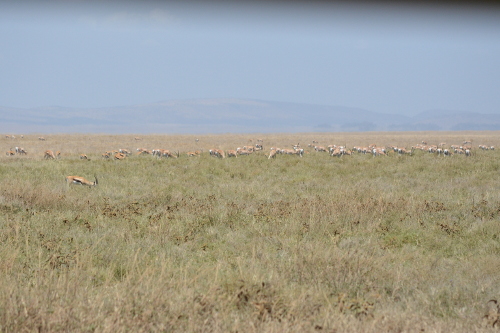 Here is a photo of a large herd of Thompson's gazelles, with a few Grants gazelles mixed in, as usual. The herd was immense, stretching from horizon to horizon right to left. The photo only
shows a small part of the whole herd. That was a problem with trying to photograph some of the large herds of animals we saw, especially Thompson's and wildebeest. The herds were so immense
that there was no way to adequately document the size with our cameras. We just tried to take it all in with our eyes.
Here is a photo of a large herd of Thompson's gazelles, with a few Grants gazelles mixed in, as usual. The herd was immense, stretching from horizon to horizon right to left. The photo only
shows a small part of the whole herd. That was a problem with trying to photograph some of the large herds of animals we saw, especially Thompson's and wildebeest. The herds were so immense
that there was no way to adequately document the size with our cameras. We just tried to take it all in with our eyes.
Topi
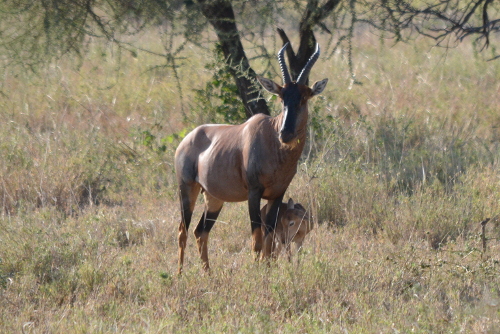 Here is a photo of a mother topi with a baby. Topis are large antelope. They were fairly common most places we went, but did not congregate in large herds.
Here is a photo of a mother topi with a baby. Topis are large antelope. They were fairly common most places we went, but did not congregate in large herds.
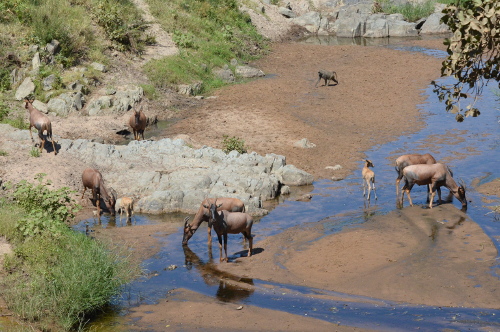 Here is a herd of topis drinking at a river with a baboon walking through the background. This is about the largest group of topis we saw.
Here is a herd of topis drinking at a river with a baboon walking through the background. This is about the largest group of topis we saw.
Warthog
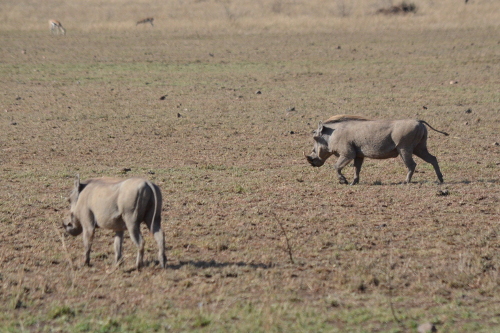 We saw quite a few warthogs. They were usually in small groups of two to three. They get their names from large, wart-like protrusions below their eyes and on their snouts. Our guide
thought they were among the ugliest animals in Africa. I personally think they are kind of cute.
We saw quite a few warthogs. They were usually in small groups of two to three. They get their names from large, wart-like protrusions below their eyes and on their snouts. Our guide
thought they were among the ugliest animals in Africa. I personally think they are kind of cute.
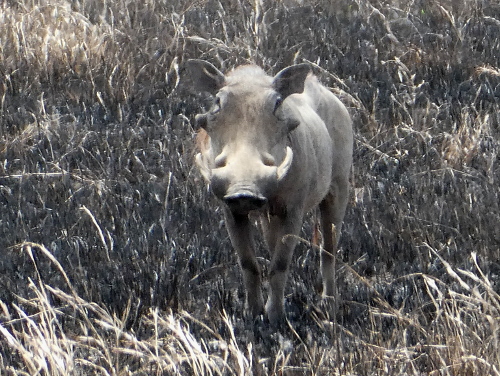 Here is probably our best close-up photo of a warthog. It is a big male with impressive tusks for fending off predators. You can see the wart-like protrusions below their eyes and on their snouts
that give them their name.
Here is probably our best close-up photo of a warthog. It is a big male with impressive tusks for fending off predators. You can see the wart-like protrusions below their eyes and on their snouts
that give them their name.
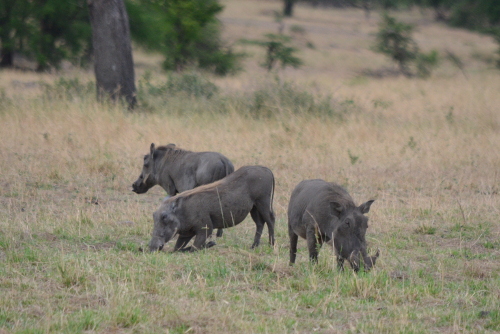 Kneeling while grazing is a trait of warthogs. Our guide called it the Bishop Position. Warthogs have another interesting trait. When they run they hold their long skinny tails perfectly erect
like radio antennas. We tried and tried to get good shots of that, but none of us succeeded.
Kneeling while grazing is a trait of warthogs. Our guide called it the Bishop Position. Warthogs have another interesting trait. When they run they hold their long skinny tails perfectly erect
like radio antennas. We tried and tried to get good shots of that, but none of us succeeded.
 Here is a photo of a mama warthog and two little babies.
Here is a photo of a mama warthog and two little babies.
Waterbuck
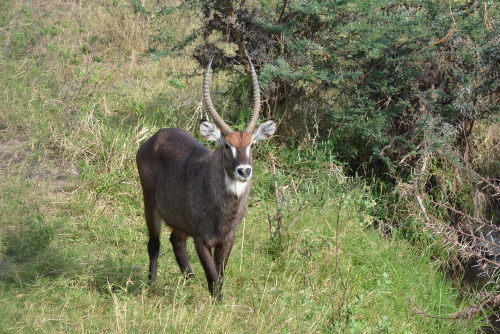 I think we all agreed that the waterbucks were the handsomest of all the antelope. They have really pretty coats and coloration, and the most perfect lyre-shaped horns.
I think we all agreed that the waterbucks were the handsomest of all the antelope. They have really pretty coats and coloration, and the most perfect lyre-shaped horns.
Wildebeest
 If the waterbuck is the handsomest antelope, the wildebeest has to be the homeliest. What they lack in beauty they more than make up for in sheer numbers. There are an estimated three
million of them wondering around the Serengeti. Their herds stretch from horizon to horizon.
If the waterbuck is the handsomest antelope, the wildebeest has to be the homeliest. What they lack in beauty they more than make up for in sheer numbers. There are an estimated three
million of them wondering around the Serengeti. Their herds stretch from horizon to horizon.
 Here is a close-up view of a wildebeest. They have long white beards below their necks, and long black manes on top of their necks. There is not much difference between males and females.
The wildebeest pretty much all looked alike.
Here is a close-up view of a wildebeest. They have long white beards below their necks, and long black manes on top of their necks. There is not much difference between males and females.
The wildebeest pretty much all looked alike.
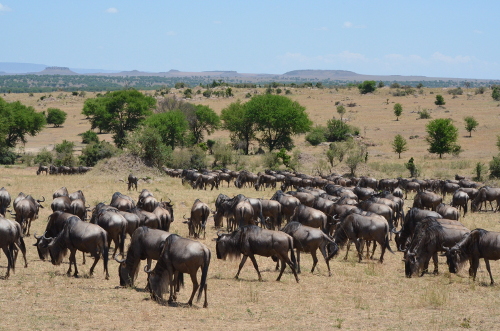 Wildebeest congregate together in huge herds. This photo shows just a few animals of a herd that stretches to the horizon. We sat in one place and watched the this one herd walk by for
maybe an hour, and there was no sign of an end to it.
Wildebeest congregate together in huge herds. This photo shows just a few animals of a herd that stretches to the horizon. We sat in one place and watched the this one herd walk by for
maybe an hour, and there was no sign of an end to it.
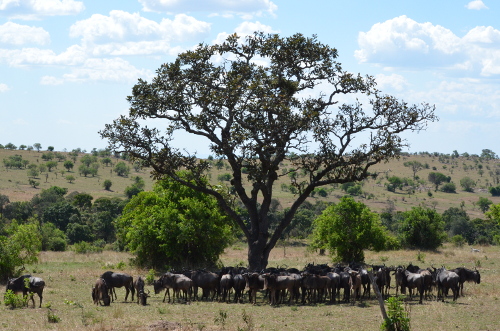 During the hottest part of the day the wildebeest will congregate together under trees and in whatever shade they can find. Every tree will have a bunch of wildebeest under it.
During the hottest part of the day the wildebeest will congregate together under trees and in whatever shade they can find. Every tree will have a bunch of wildebeest under it.
 As the wildebeest migrate across the Serengeti in search of fresh grass, they come to obstacles like the Mara River. The wildebeest will pile up on the edge of the river until the sheer pressure
of their numbers pushes them to start crossing. Sometimes they cross a few at a time. sometimes they cross hundreds or thousands at a time in a huge stampede.
As the wildebeest migrate across the Serengeti in search of fresh grass, they come to obstacles like the Mara River. The wildebeest will pile up on the edge of the river until the sheer pressure
of their numbers pushes them to start crossing. Sometimes they cross a few at a time. sometimes they cross hundreds or thousands at a time in a huge stampede.
The reason for our stay at Mara River and the timing our our visit was specifically to try to see the wildebeest crossing. We got lucky. Our timing was perfect. We caught several large
crossings.
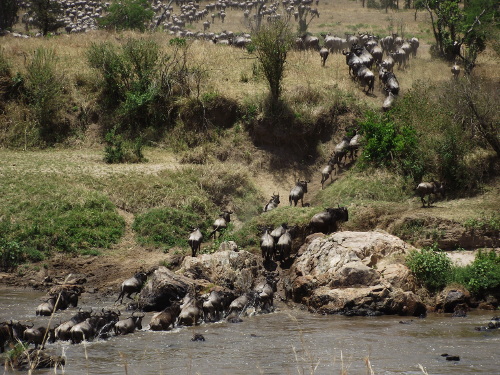 This photo gives you some small idea of the sheer numbers of wildebeest that were crossing the river. They crossed at multiple points. Sometimes in small groups, sometimes in thousands.
Sometimes they walked or swam across calmly. Sometimes they crossed in a massive, frenzied stampede that raised huge clouds of dust and sent water spraying off in all directions.
This photo gives you some small idea of the sheer numbers of wildebeest that were crossing the river. They crossed at multiple points. Sometimes in small groups, sometimes in thousands.
Sometimes they walked or swam across calmly. Sometimes they crossed in a massive, frenzied stampede that raised huge clouds of dust and sent water spraying off in all directions.
Here is a video of a group of Wildebeest crossing the Mara River in Tanzania. Watch to the end for a big surprise. Hint: not all the wildebeest make it safely to the other side.
 Click on this photo to see a full-screen version of it. All those little dots are wildebeest. There are thousands of them in this one photo, and this photo only shows
a small part of the immense herd that was forming up on the other side of the river. It literally stretched from horizon to horizon to the left and right of where this photo is
centered.
Click on this photo to see a full-screen version of it. All those little dots are wildebeest. There are thousands of them in this one photo, and this photo only shows
a small part of the immense herd that was forming up on the other side of the river. It literally stretched from horizon to horizon to the left and right of where this photo is
centered.
Zebra
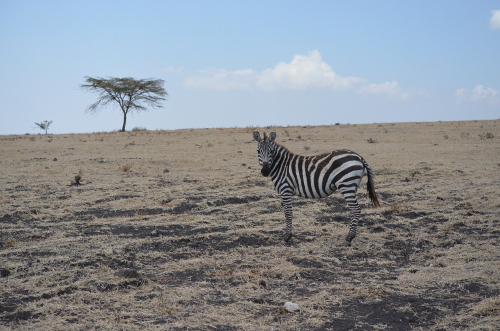 Here is a photo of a lone zebra. We saw thousands of zebras, singularly, in small groups and in huge herds. Something about this photo of a lone zebra in front of a lone
acacia tree just grabs me. I really like it.
Here is a photo of a lone zebra. We saw thousands of zebras, singularly, in small groups and in huge herds. Something about this photo of a lone zebra in front of a lone
acacia tree just grabs me. I really like it.
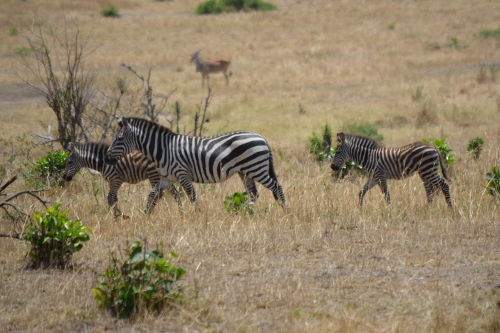 Here is a photo of a female zebra and a couple of colts. Notice that the young zebras have brown stripes. They don't darken to black until they mature.
Here is a photo of a female zebra and a couple of colts. Notice that the young zebras have brown stripes. They don't darken to black until they mature.
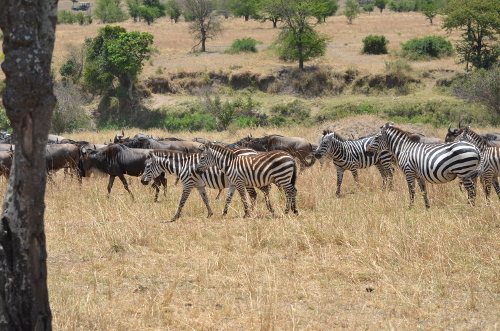 This photo shows a mixed herd of zebras and wildebeest. Zebras and wildebeest intermingle frequently. There are usually a whole lot more wildebeest though.
This photo shows a mixed herd of zebras and wildebeest. Zebras and wildebeest intermingle frequently. There are usually a whole lot more wildebeest though.
Here is a video of a herd of zebras and wildebeest drinking at the edge of the Mara River in Tanzania. Our guide explained that the zebras and wildebeest have a symbiotic relationship, and
are often found in mixed herds. The zebras like to eat tall grass. The wildebeest like to eat shorter grass so they follow behind as the zebras crop the grass shorter. Also the wildebeest
have better hearing than the zebras, but the zebras have better eyesight than the wildebeest. So they complement each other when watching and listening for danger. Our guide also said that
Zebras are better at finding water. So the wildebeest follow them to the water sources. We almost always saw zebras and wildebeest together or at least in close proximity.
Monkey
Vervet Monkey
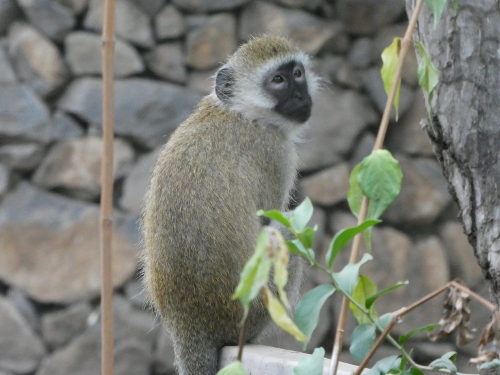 We started seeing vervet monkeys our first day in Africa. They were all over at the Rivertrees resort where we spent our first night. Once we left civilization and went into the Serengeti,
they were there too. We pretty much saw them everywhere in Tanzania except in the middle of towns and cities.
We started seeing vervet monkeys our first day in Africa. They were all over at the Rivertrees resort where we spent our first night. Once we left civilization and went into the Serengeti,
they were there too. We pretty much saw them everywhere in Tanzania except in the middle of towns and cities.
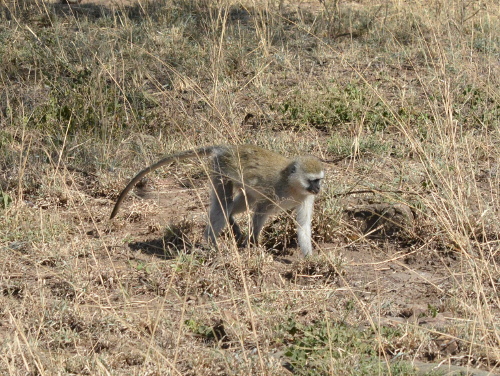 Here is one of the many vervet monkeys we saw out on the Serengeti.
Here is one of the many vervet monkeys we saw out on the Serengeti.
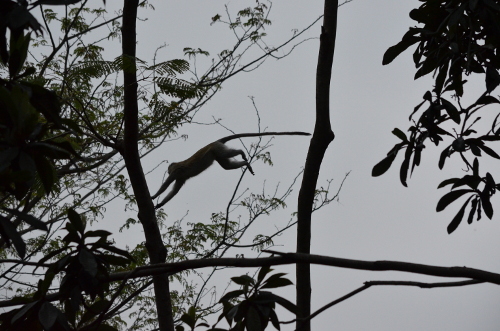 A vervet monkey jumping between branches.
A vervet monkey jumping between branches.
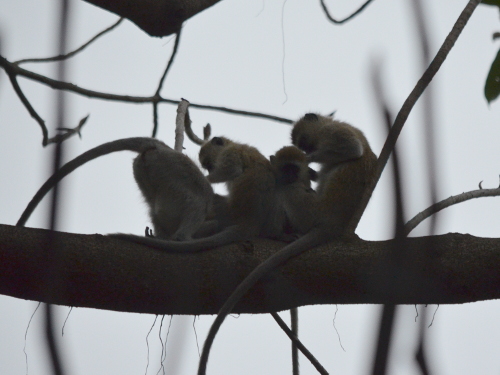 A group of four vervet monkeys grooming each other up in a tree.
A group of four vervet monkeys grooming each other up in a tree.
Olive Baboon
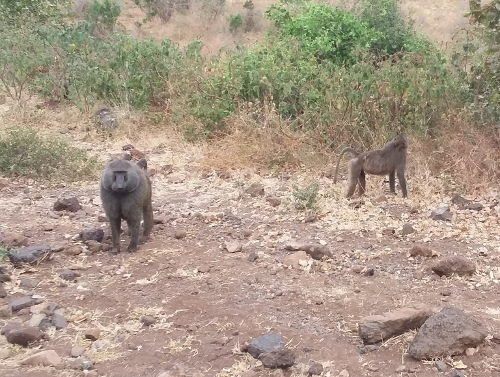 We started seeing baboons as soon as we left the Arusha area and started getting into the wild. We saw lots of baboons. Never large groups, but a lot of small groups of baboons
all over the rural areas of Tanzania. They weren't just in the wildlife parks.
We started seeing baboons as soon as we left the Arusha area and started getting into the wild. We saw lots of baboons. Never large groups, but a lot of small groups of baboons
all over the rural areas of Tanzania. They weren't just in the wildlife parks.
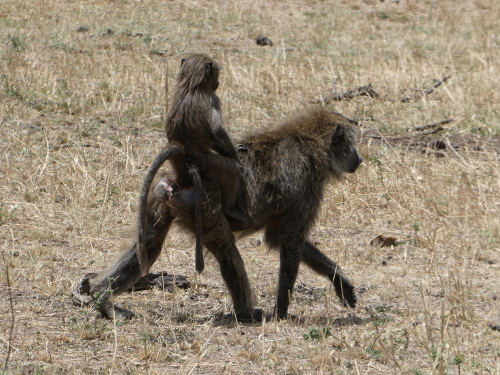 Here is a photo of a mother baboon with a baby riding on her back in what is known as the jockey position.
Here is a photo of a mother baboon with a baby riding on her back in what is known as the jockey position.
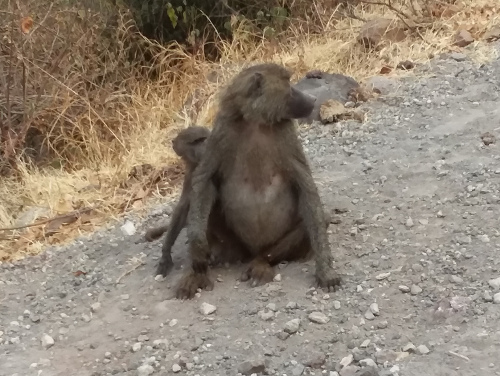 Another photo of a mother baboon with a baby.
Another photo of a mother baboon with a baby.
Birds
Grey-backed Fiscal
 My Fiancee is a real bird nut. So bird spotting and watching was always going to be a big part of this trip. I said several times that this trip seemed more like a birding
safari with a few other animals thrown in. I actually enjoyed seeing all the different birds of the Serengeti too.
My Fiancee is a real bird nut. So bird spotting and watching was always going to be a big part of this trip. I said several times that this trip seemed more like a birding
safari with a few other animals thrown in. I actually enjoyed seeing all the different birds of the Serengeti too.
One day when we stopped in the shade of an acacia tree and had a box lunch, this fellow sat on a branch above us for the longest time. We got to get lots of nice photos of him.
African Fish Eagle
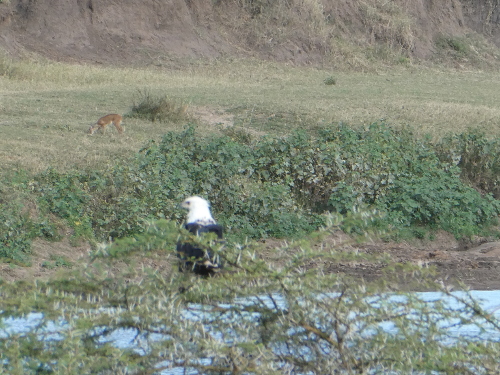 Here is a shot of an African Fish Eagle sitting on a thorny acacia tree with an antelope in the background. This shot is a pretty extreme zoom, since the eagle was far away. So it isn't as
clear as I'd like. We saw a couple of these magnificent eagles. We all remarked on how similar they seemed in coloration to American Bald Eagles.
Here is a shot of an African Fish Eagle sitting on a thorny acacia tree with an antelope in the background. This shot is a pretty extreme zoom, since the eagle was far away. So it isn't as
clear as I'd like. We saw a couple of these magnificent eagles. We all remarked on how similar they seemed in coloration to American Bald Eagles.
Flamingos
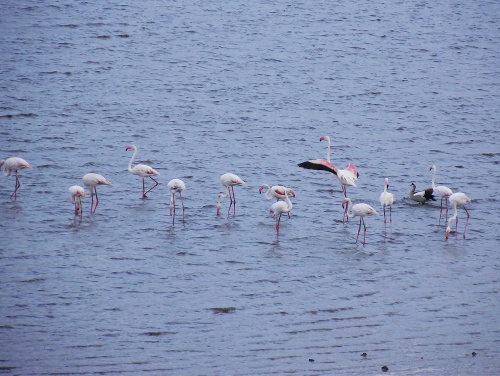 We saw this flock of pink flamingos on one of the alkali lakes of the Rift Valley.
We saw this flock of pink flamingos on one of the alkali lakes of the Rift Valley.
Guinea Fowl
 We saw a lot of these helmeted Guinea fowl all over Tanzania. There were groups of them almost everywhere we went.
We saw a lot of these helmeted Guinea fowl all over Tanzania. There were groups of them almost everywhere we went.
Kori bustard
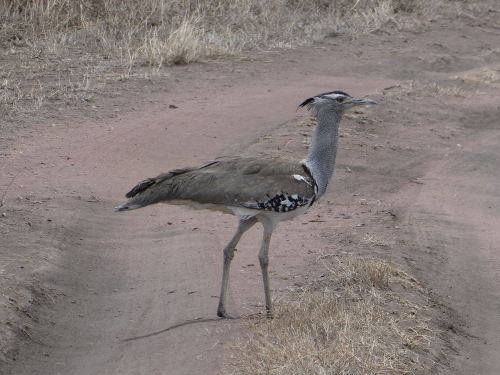 Kori Bustards are the largest flying bird in Africa. We started seeing them as soon as we got away from the towns and out into rural areas.
Kori Bustards are the largest flying bird in Africa. We started seeing them as soon as we got away from the towns and out into rural areas.
Lilac-breasted Roller
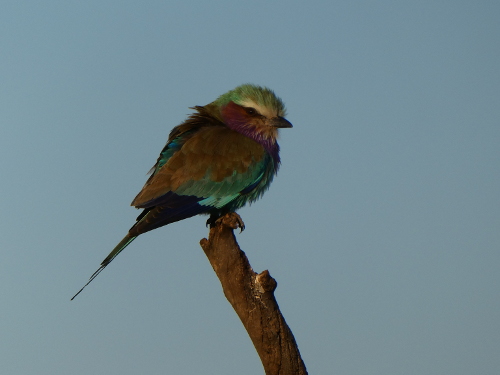 A very pretty and colorful little bird.
A very pretty and colorful little bird.
Marabou Stork
 We saw quite a few Marabou Storks. Turns out they are carrion eaters. They flocked to the Mara River for the same reason we did, for the wildebeest migration. They will eat well on the
carcasses of dead wildebeest. Wherever there were vultures eating something dead, there were usually some Marabou Storks there too trying to get a piece of the action.
We saw quite a few Marabou Storks. Turns out they are carrion eaters. They flocked to the Mara River for the same reason we did, for the wildebeest migration. They will eat well on the
carcasses of dead wildebeest. Wherever there were vultures eating something dead, there were usually some Marabou Storks there too trying to get a piece of the action.
Ostrich
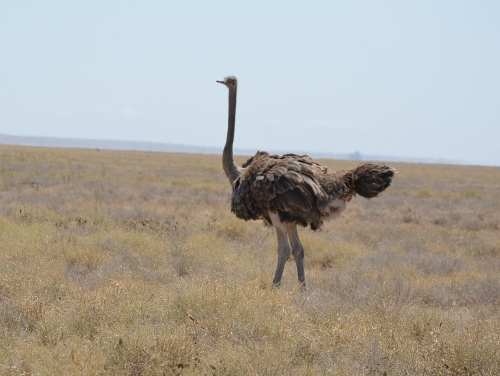 Here is a photo of a female ostrich.
Ostriches were surprisingly (to me) common on the Serengeti. I wasn't expecting to see so many of them. We started seeing them our first day on the Serengeti, and saw a lot of them.
They were usually in groups of two at the most. Sometimes we only saw individuals, but there were usually some ostriches around whenever we were out on the open plains.
Here is a photo of a female ostrich.
Ostriches were surprisingly (to me) common on the Serengeti. I wasn't expecting to see so many of them. We started seeing them our first day on the Serengeti, and saw a lot of them.
They were usually in groups of two at the most. Sometimes we only saw individuals, but there were usually some ostriches around whenever we were out on the open plains.
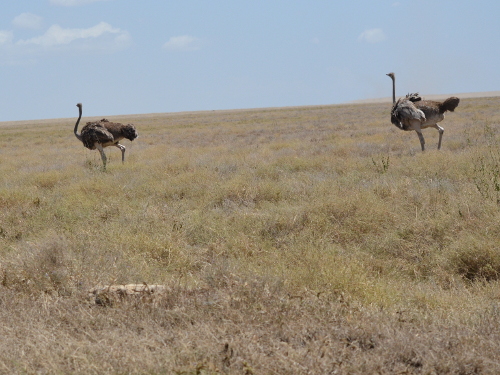 Here is a photo of a pair of female ostriches who walked by our safari truck.
Here is a photo of a pair of female ostriches who walked by our safari truck.
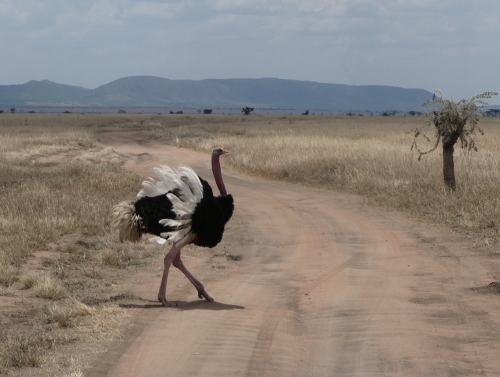 Here is a photo of a male ostrich putting on its mating display.
Here is a photo of a male ostrich putting on its mating display.
Owl
 Here is a photo of a group of three sleeping owls we saw in a tree as we were getting ready to leave Rivertrees Resort. One of the porters carrying luggage pointed them out to us.
Here is a photo of a group of three sleeping owls we saw in a tree as we were getting ready to leave Rivertrees Resort. One of the porters carrying luggage pointed them out to us.
Oxpecker
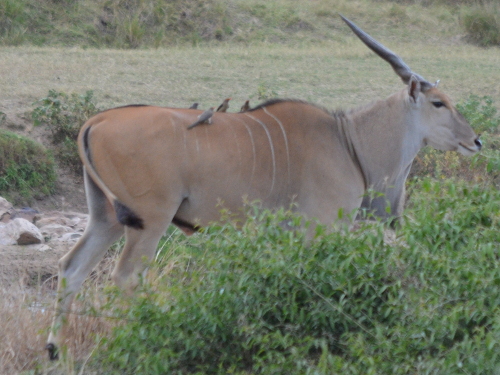 Here is a photo of a group of yellow-billed oxpeckers riding on the back of an eland. We saw a lot of oxpeckers, but unfortunately didn't get any good close-up photos of any.
They were present wherever there were big animals. They clean ticks and other parasites from the animals.
Here is a photo of a group of yellow-billed oxpeckers riding on the back of an eland. We saw a lot of oxpeckers, but unfortunately didn't get any good close-up photos of any.
They were present wherever there were big animals. They clean ticks and other parasites from the animals.
Red-Cheeked Cordon Blue
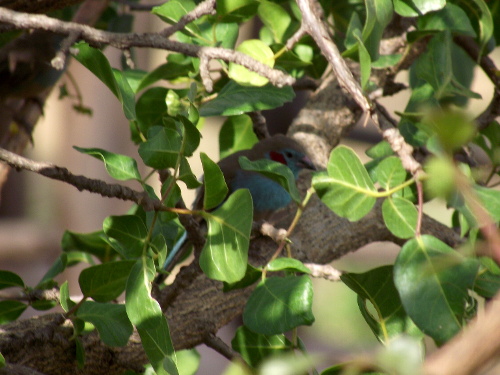 Here is a photo of a red-cheeked cordon bleu. This cute little bird flitted around in a bush beside our tent at Mara River. Leslie and Mary were desperate to try to get a decent photo of it.
They tried and tried, but it was too fast and was always on the wrong side of the bush. It was kind of comical to watch. This is the best photo they got of it.
Here is a photo of a red-cheeked cordon bleu. This cute little bird flitted around in a bush beside our tent at Mara River. Leslie and Mary were desperate to try to get a decent photo of it.
They tried and tried, but it was too fast and was always on the wrong side of the bush. It was kind of comical to watch. This is the best photo they got of it.
Red-Necked Spur Fowl
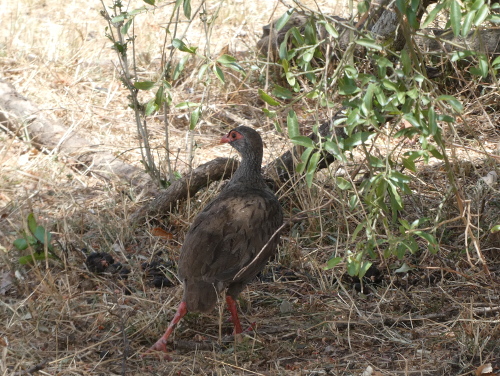 Here is a photo of a red-necked spurfowl. Unfortunately it is facing away from us and the photo doesn't show its bright red neck, but we do get to see its red legs, beak and area around the eyes.
Here is a photo of a red-necked spurfowl. Unfortunately it is facing away from us and the photo doesn't show its bright red neck, but we do get to see its red legs, beak and area around the eyes.
Secretary Bird
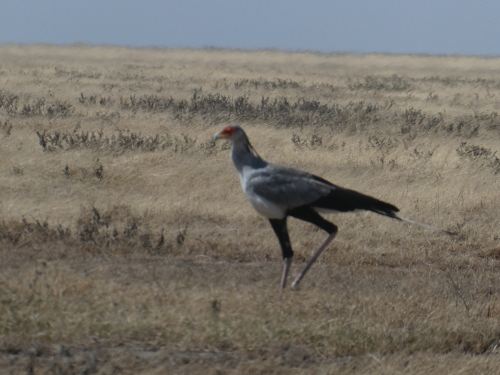 We saw a couple of secretary birds while we were in Tanzania. This is my best photo of one. Wish I could have gotten some better photos.
We saw a couple of secretary birds while we were in Tanzania. This is my best photo of one. Wish I could have gotten some better photos.
Superb Starling
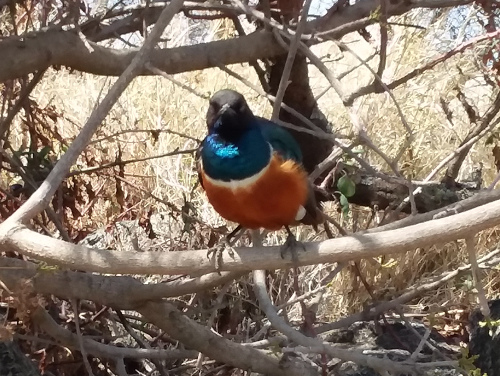 Superb starlings are very colorful and common birds. We saw lots of them all over the place. They are very pretty birds we never got tired of seeing.
Superb starlings are very colorful and common birds. We saw lots of them all over the place. They are very pretty birds we never got tired of seeing.
Tawny Eagle
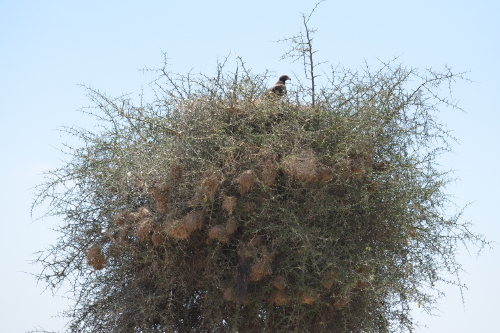 One of the first animals we saw after entering Serengeti National Park was this tawny eagle on top of a tree full of old weaver nests.
One of the first animals we saw after entering Serengeti National Park was this tawny eagle on top of a tree full of old weaver nests.
Vulture
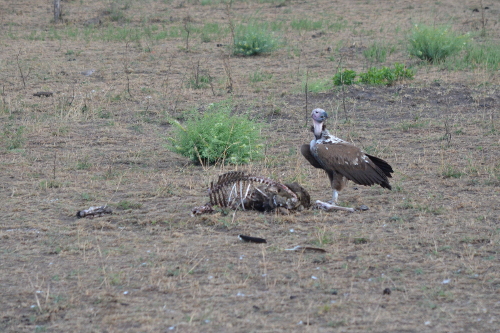 A lappet-faced African vulture picking over an old carcass.
A lappet-faced African vulture picking over an old carcass.
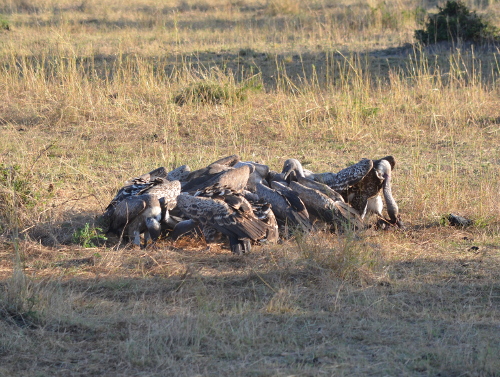 A feeding frenzy of vultures attacking a wildebeest carcass after the hyenas who had been feeding on it left.
A feeding frenzy of vultures attacking a wildebeest carcass after the hyenas who had been feeding on it left.
Weavers
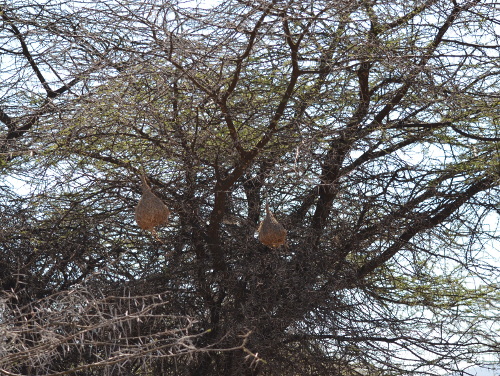 We saw a lot of weaver nests in trees. Different species make different shaped nests. These particular nests were made by Baglafecht weavers. Unfortunately we did not see any weavers
of that particular species. It was not nesting season for the weavers. Most of the nests we saw were old and falling apart. A few were still in good condition.
We saw a lot of weaver nests in trees. Different species make different shaped nests. These particular nests were made by Baglafecht weavers. Unfortunately we did not see any weavers
of that particular species. It was not nesting season for the weavers. Most of the nests we saw were old and falling apart. A few were still in good condition.
White-headed Buffalo Weaver
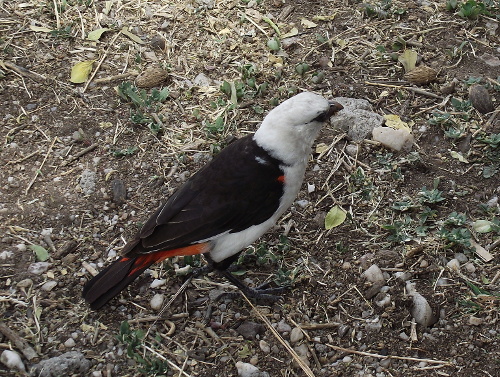 Here is a photo of a weaver bird we did see. This is a white-headed buffalo weaver. A very pretty little bird. There were quite a lot of them at one place where we stopped to have a
picnic lunch on our way to Ronjo Camp.
Here is a photo of a weaver bird we did see. This is a white-headed buffalo weaver. A very pretty little bird. There were quite a lot of them at one place where we stopped to have a
picnic lunch on our way to Ronjo Camp.
Reptiles
Leopard Tortoise
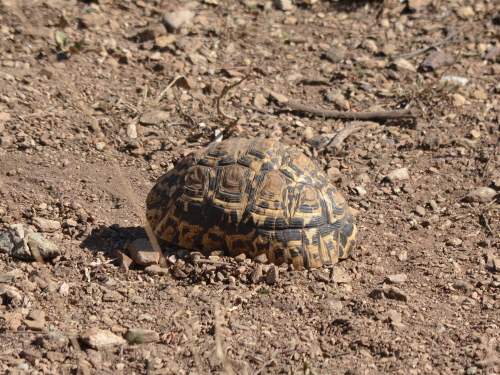 A large and colorful leopard tortoise all tucked up inside its shell. This one was about the size of a soccer ball.
A large and colorful leopard tortoise all tucked up inside its shell. This one was about the size of a soccer ball.
Agama agama
 We saw a lot of these pretty red and blue Agama agama lizards. They are also known as Spiderman lizards. There is nothing in the photo to give it scale, but these are quite large lizards.
We saw several at least a foot long.
We saw a lot of these pretty red and blue Agama agama lizards. They are also known as Spiderman lizards. There is nothing in the photo to give it scale, but these are quite large lizards.
We saw several at least a foot long.
Insects
Army Ants
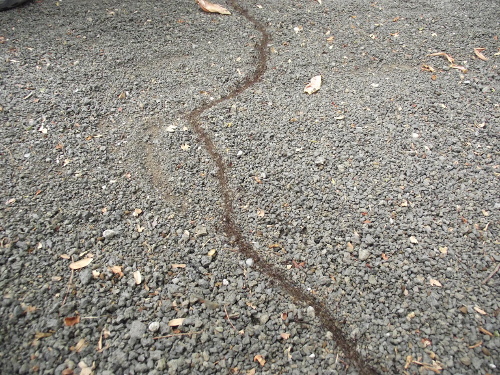 We came across this line of army ants crossing a gravel road in Rivertrees. It was like a living river of ants that flowed across the road, carving it's own mini canyon through the gravel.
The number of ants was amazing. The line went for as far as we could see through the undergrowth on each side of the road. Bits and pieces of dismembered insects and small animals flowed
along the stream, carried by the ants. It was an impressive, and a little bit scary sight. We couldn't help but wonder what would happen if army ants got into our bungalow.
We came across this line of army ants crossing a gravel road in Rivertrees. It was like a living river of ants that flowed across the road, carving it's own mini canyon through the gravel.
The number of ants was amazing. The line went for as far as we could see through the undergrowth on each side of the road. Bits and pieces of dismembered insects and small animals flowed
along the stream, carried by the ants. It was an impressive, and a little bit scary sight. We couldn't help but wonder what would happen if army ants got into our bungalow.
You can see in this photo how the stream of ants has meandered back and forth across the road, just like a river meanders across its flood plain. There are even cutoff oxbow arcs, just like
with a meandering river. The same fundamental patterns found in nature repeat in different ways and at different scales.
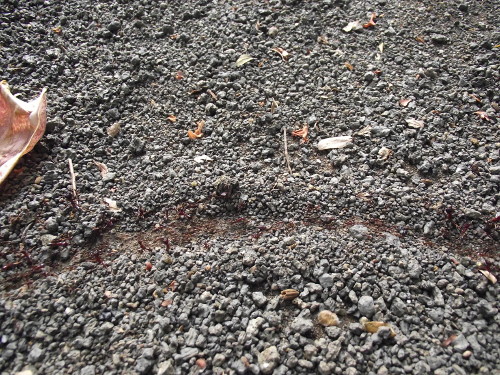 Here is a close-up of the stream of army ants crossing the road. There were huge soldier ants guarding the edges of the stream, and uncountable numbers of small worker ants
flowing along the stream. The bits of gravel (boulder sized to the ants) were pushed aside to make a clear path. Watching them was a mesmerizing sight.
Here is a close-up of the stream of army ants crossing the road. There were huge soldier ants guarding the edges of the stream, and uncountable numbers of small worker ants
flowing along the stream. The bits of gravel (boulder sized to the ants) were pushed aside to make a clear path. Watching them was a mesmerizing sight.
Termites
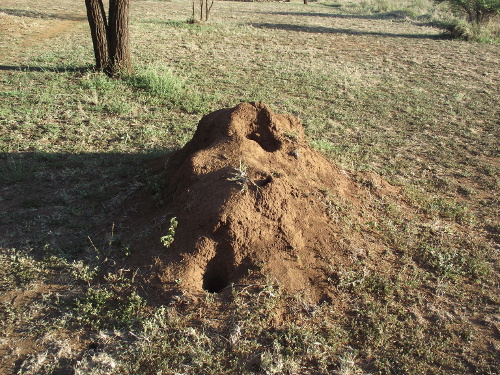 This is a photo of a termite mound at Ronjo Camp. There were thousands of termite mounds all across the Serengeti. This is a small one we got a good look at inside one of the camps we stayed
in. By mass alone, termites probably out-weigh all the large animals roaming the Serengeti, even though individually they are tiny, there are millions living in each large mound.
This is a photo of a termite mound at Ronjo Camp. There were thousands of termite mounds all across the Serengeti. This is a small one we got a good look at inside one of the camps we stayed
in. By mass alone, termites probably out-weigh all the large animals roaming the Serengeti, even though individually they are tiny, there are millions living in each large mound.
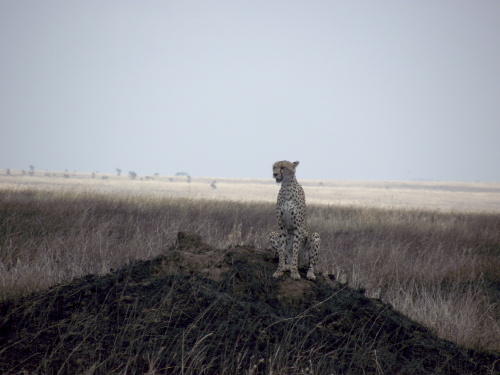 Out on the flat areas of the Serengeti termite mounds can be the highest point for miles around. We often saw animals standing on them to get a better view. Here a cheetah is using one to
survey the landscape for something to hunt. We also saw grazers standing on them watching for predators trying to sneak up on them in the tall grass.
Out on the flat areas of the Serengeti termite mounds can be the highest point for miles around. We often saw animals standing on them to get a better view. Here a cheetah is using one to
survey the landscape for something to hunt. We also saw grazers standing on them watching for predators trying to sneak up on them in the tall grass.
Tsetse fly
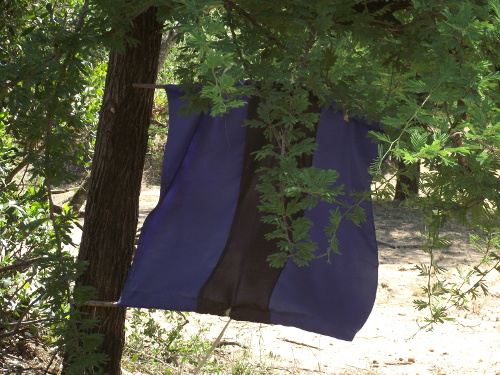 Fortunately we did not see any tsetse flies. They are very dangerous and can carry African Sleeping Sickness. We were warned to wear long sleeves and long pants and wear insect repellent with
DEET to prevent getting bitten by them, as well as to keep malaria carrying mosquitoes away from us. This photo shows a tsetse fly trap hung on a tree near a populated area. Tsetse flies are
attracted to the black and blue fabric, which has been treated with an insecticide. We were also warned not to wear dark colored clothing, especially not black or dark blue.
Fortunately we did not see any tsetse flies. They are very dangerous and can carry African Sleeping Sickness. We were warned to wear long sleeves and long pants and wear insect repellent with
DEET to prevent getting bitten by them, as well as to keep malaria carrying mosquitoes away from us. This photo shows a tsetse fly trap hung on a tree near a populated area. Tsetse flies are
attracted to the black and blue fabric, which has been treated with an insecticide. We were also warned not to wear dark colored clothing, especially not black or dark blue.
Plants
Acacia Trees
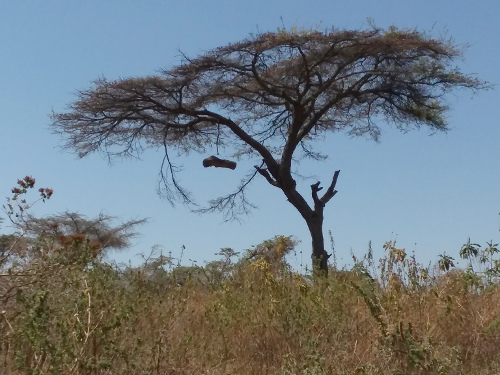 This is a photo of an umbrella acacia tree, the iconic tree of the Serengeti. We saw them by the millions. They provide food, shelter and shade for many of the animals of the Serengeti.
This particular acacia tree is also providing honey. The Maasai people make beehives out of hollow logs and hang them in the acacia trees. The trees are absolutely covered in little yellow
flowers at certain times of the year. Acacia trees near populated areas will often have one or several of these simple beehives hung under them. I got a taste of the fresh acacia honey. It is a
very clear and light pale yellow, almost colorless honey. It was absolutely delicious. I bought some acacia honey after I got home.
I like to put it in my morning tea as a little taste reminder of my time in Africa.
This is a photo of an umbrella acacia tree, the iconic tree of the Serengeti. We saw them by the millions. They provide food, shelter and shade for many of the animals of the Serengeti.
This particular acacia tree is also providing honey. The Maasai people make beehives out of hollow logs and hang them in the acacia trees. The trees are absolutely covered in little yellow
flowers at certain times of the year. Acacia trees near populated areas will often have one or several of these simple beehives hung under them. I got a taste of the fresh acacia honey. It is a
very clear and light pale yellow, almost colorless honey. It was absolutely delicious. I bought some acacia honey after I got home.
I like to put it in my morning tea as a little taste reminder of my time in Africa.
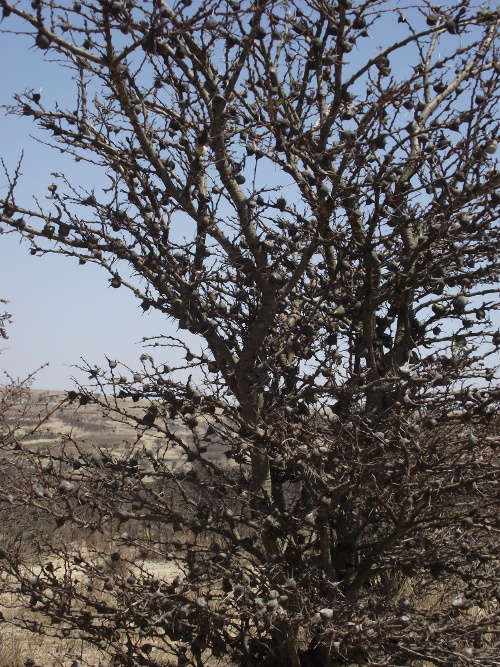 As well as the common umbrella acacias, we also saw a lot of whistling acacias. The whistling acacias are interesting in that they have hollow galls at
the base of their thorns and a symbiotic species of biting ants that lives in the galls. Between the thorns and the biting ants, the whistling acacia is well protected from grazers. They get
their name from a whistling sound that can sometimes be heard as the wind blows across the openings in their hollow galls, just like blowing across the top of a bottle can make a whistling
sound. This time of year the whistling acacias had dropped their leaves and were all barren.
As well as the common umbrella acacias, we also saw a lot of whistling acacias. The whistling acacias are interesting in that they have hollow galls at
the base of their thorns and a symbiotic species of biting ants that lives in the galls. Between the thorns and the biting ants, the whistling acacia is well protected from grazers. They get
their name from a whistling sound that can sometimes be heard as the wind blows across the openings in their hollow galls, just like blowing across the top of a bottle can make a whistling
sound. This time of year the whistling acacias had dropped their leaves and were all barren.
As well as umbrella and whistling acacias, we also saw lots of yellow fever acacias, and Madagascar acacias. The acacias are the most common trees of the Serengeti and surrounding lands.
Sausage Tree
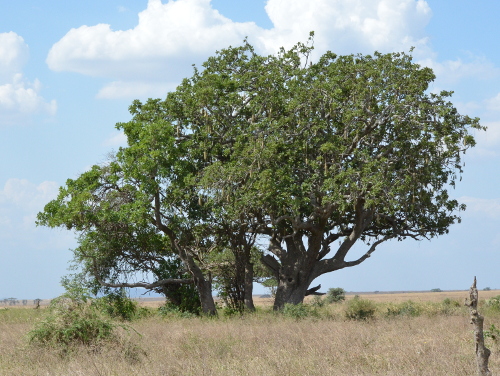 Sausage trees got their name from the long fruits hanging from them that look for all the world like sausages hanging in a butcher's window. Sausage trees are favorites for leopards to hide in
because of their thick and sturdy branches and dense foliage. We always looked closely at any sausage trees we passed for leopards or their kills which they drag up into trees.
Sausage trees got their name from the long fruits hanging from them that look for all the world like sausages hanging in a butcher's window. Sausage trees are favorites for leopards to hide in
because of their thick and sturdy branches and dense foliage. We always looked closely at any sausage trees we passed for leopards or their kills which they drag up into trees.
Candelabra Tree
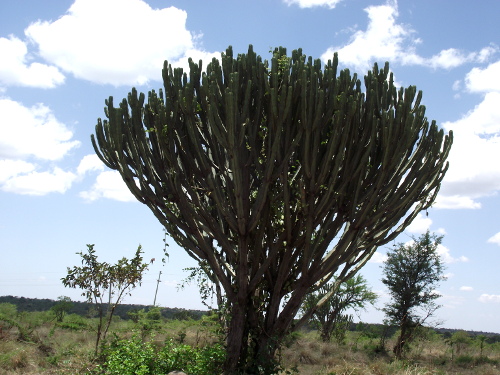 Candelabra trees are a very unique looking trees. We saw quite a few of them in Tanzania.
Candelabra trees are a very unique looking trees. We saw quite a few of them in Tanzania.
Boabab Tree
 Boabab trees are very funny looking trees. A lot of people think they look like they are upside-down, with their roots in the air. This time of year there were no leaves on the tree. Here Leslie and
I are standing in front of one we passed on the way to Ngorongoro.
Boabab trees are very funny looking trees. A lot of people think they look like they are upside-down, with their roots in the air. This time of year there were no leaves on the tree. Here Leslie and
I are standing in front of one we passed on the way to Ngorongoro.
Oldupai
 Olduvai Gorge get's it's name from a misunderstanding and mispronunciation of the name of this plant. A western naturalist traveling through the area asked the local Maasai what the name of the gorge was.
They thought he was asking the name of the plant. He mispronounced the name anyway, and the rest is history. Oldupai is a tough, fibrous, succulent plant that retains water and is chewed by some animals
during dry spells for the moisture. It also has some medicinal properties, and is used for both cordage and for making bandages by the local people. It grows in very dense thickets in places.
The Maasai often use the center of dense and nearly impenetrable thickets of oldupai as natural corals for their livestock to protect them from predators.
Olduvai Gorge get's it's name from a misunderstanding and mispronunciation of the name of this plant. A western naturalist traveling through the area asked the local Maasai what the name of the gorge was.
They thought he was asking the name of the plant. He mispronounced the name anyway, and the rest is history. Oldupai is a tough, fibrous, succulent plant that retains water and is chewed by some animals
during dry spells for the moisture. It also has some medicinal properties, and is used for both cordage and for making bandages by the local people. It grows in very dense thickets in places.
The Maasai often use the center of dense and nearly impenetrable thickets of oldupai as natural corals for their livestock to protect them from predators.
a lady to
learn how
to meet her

